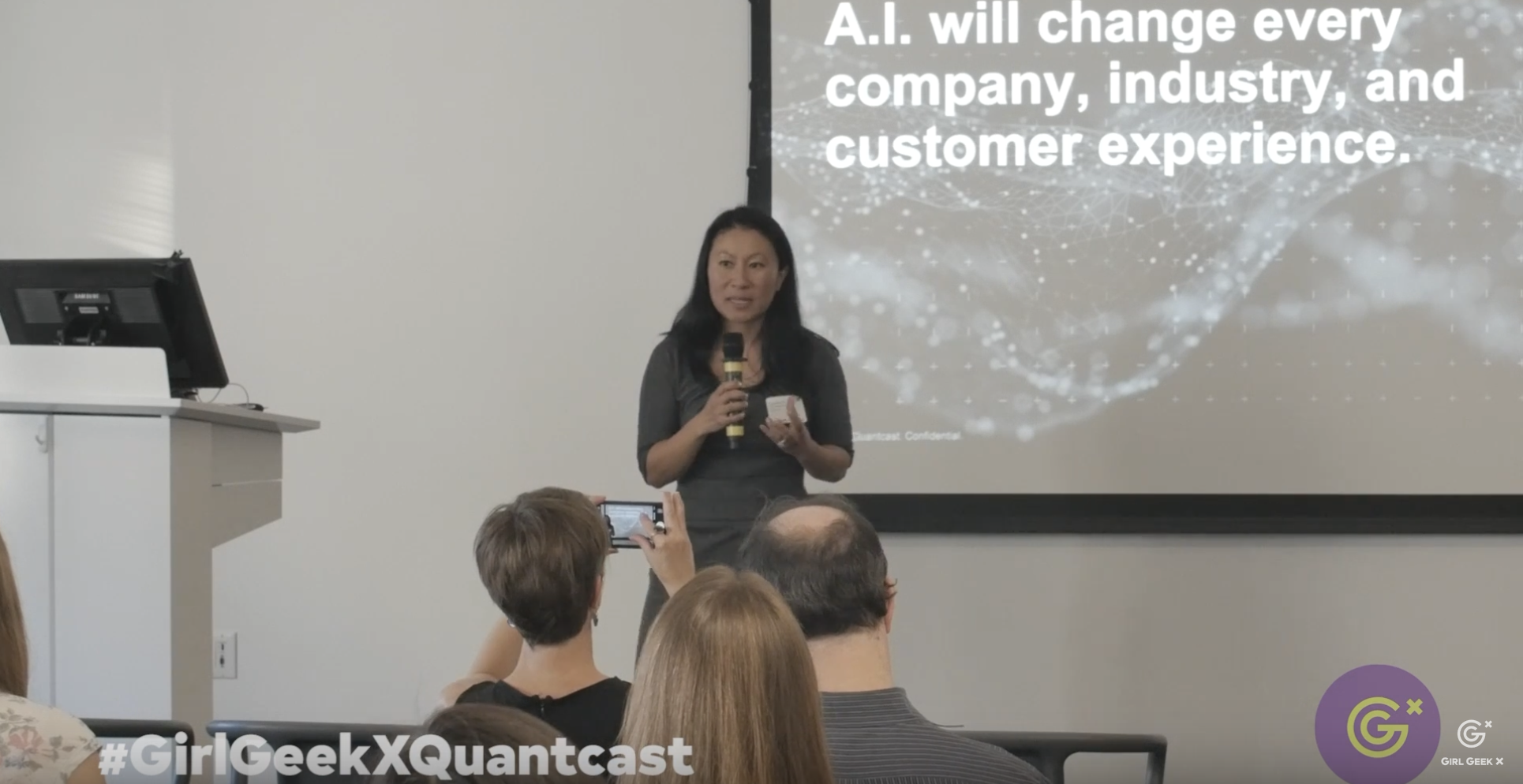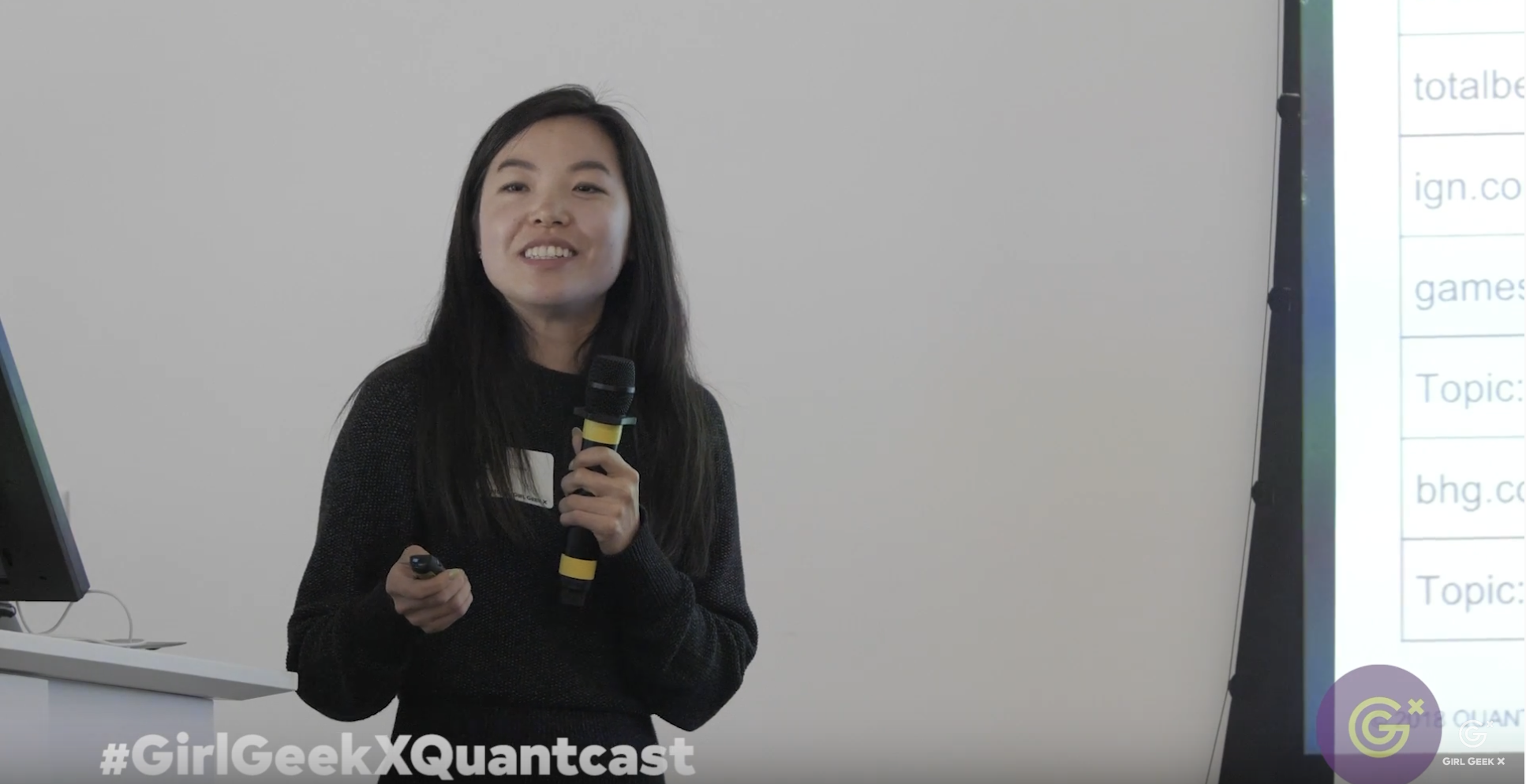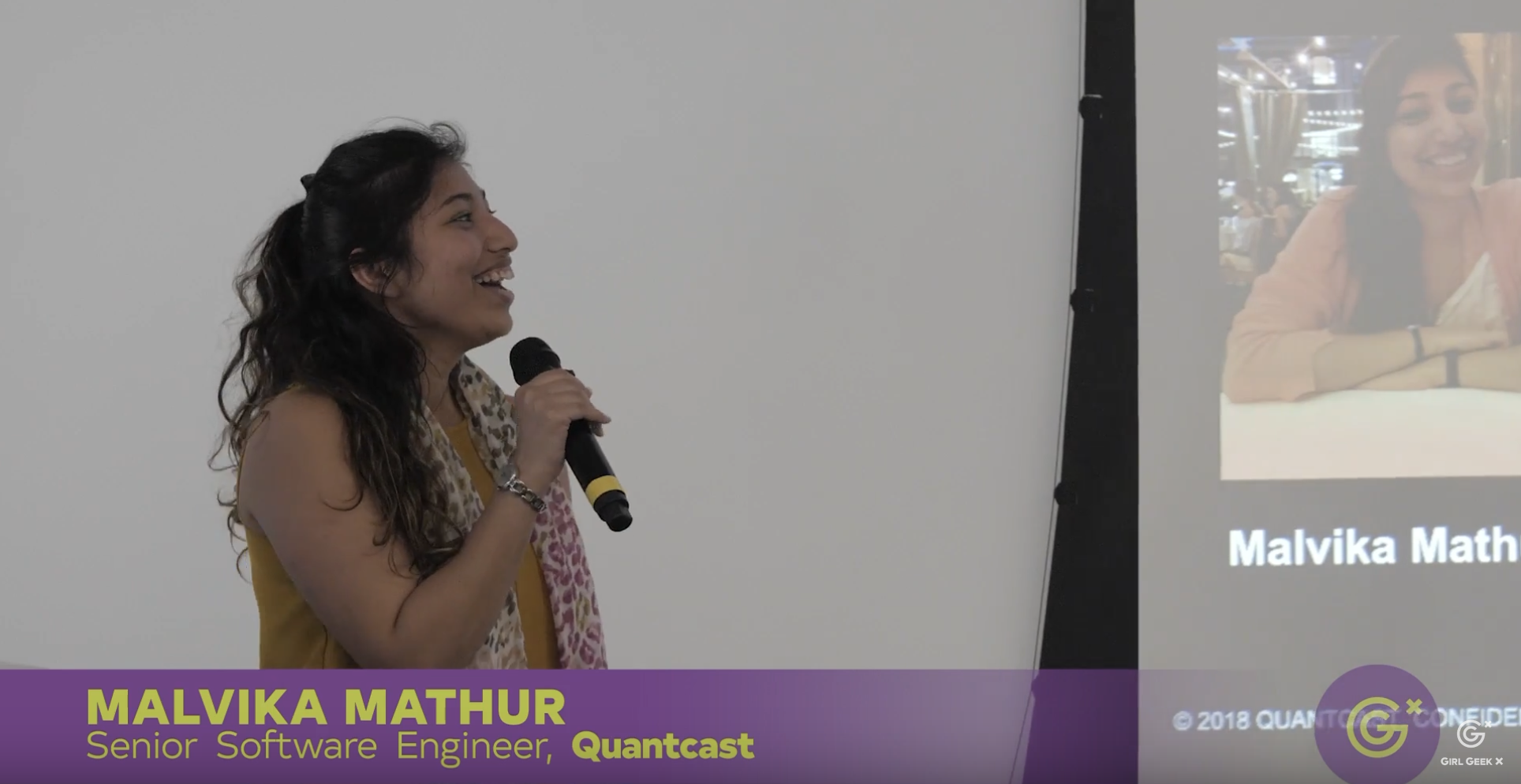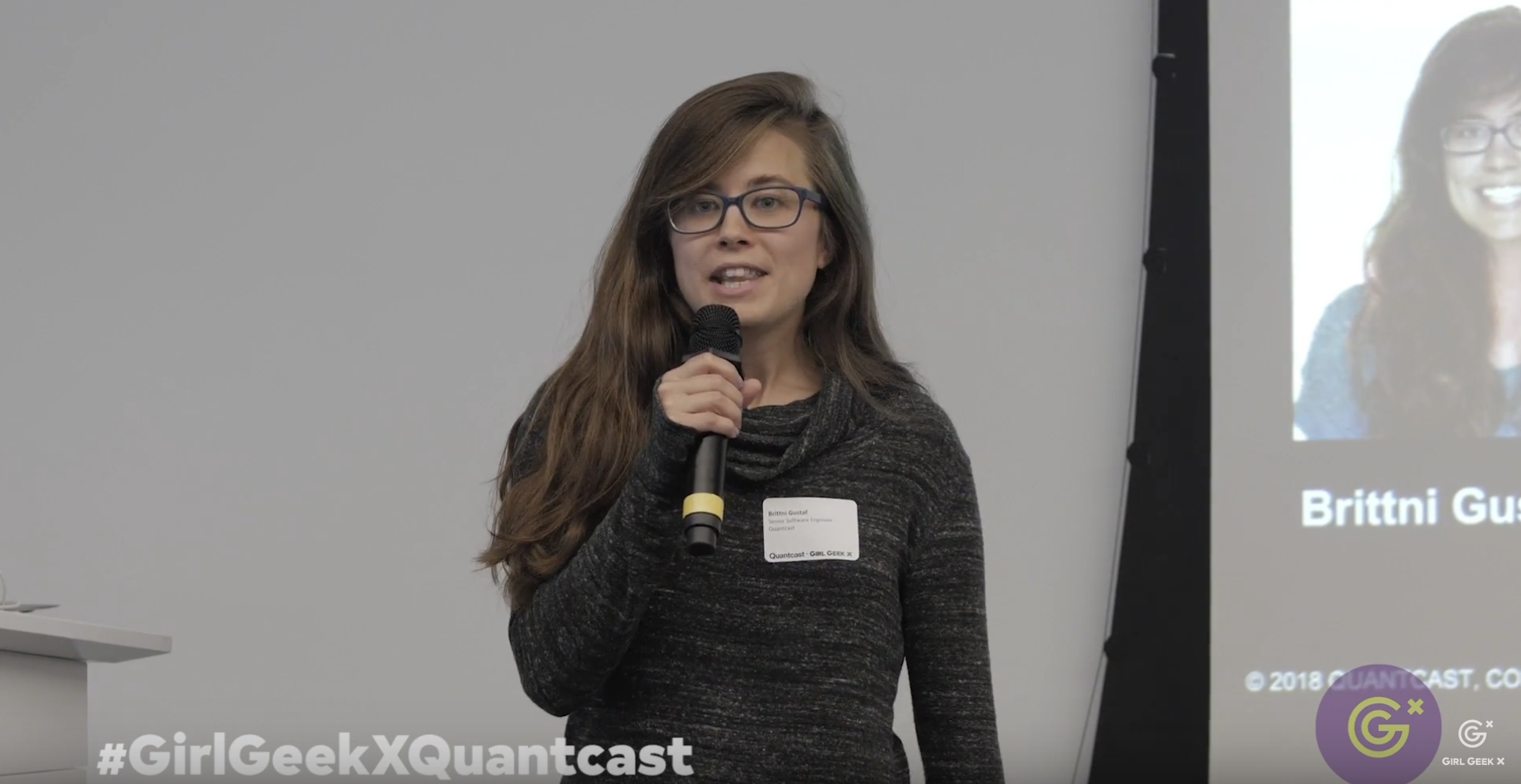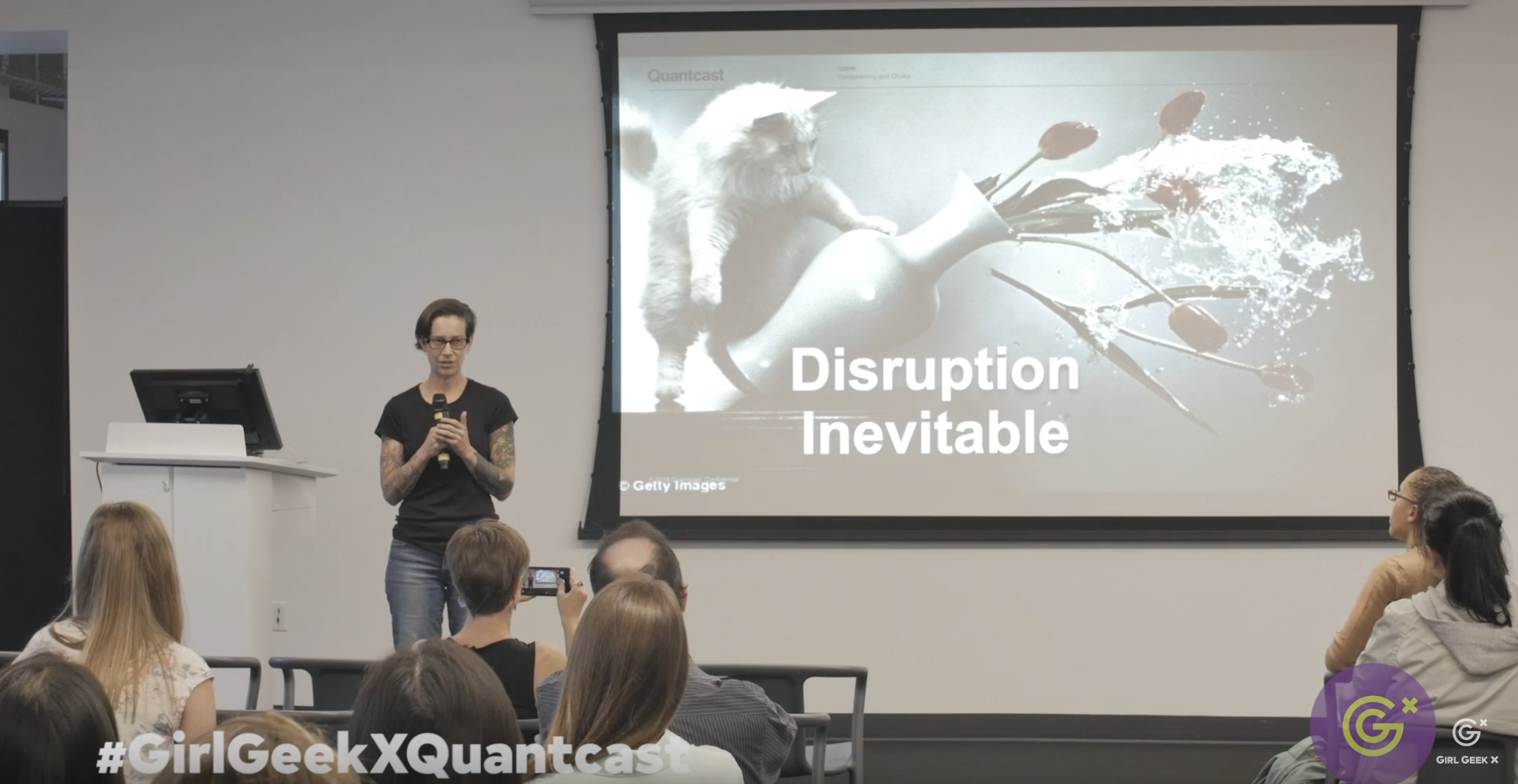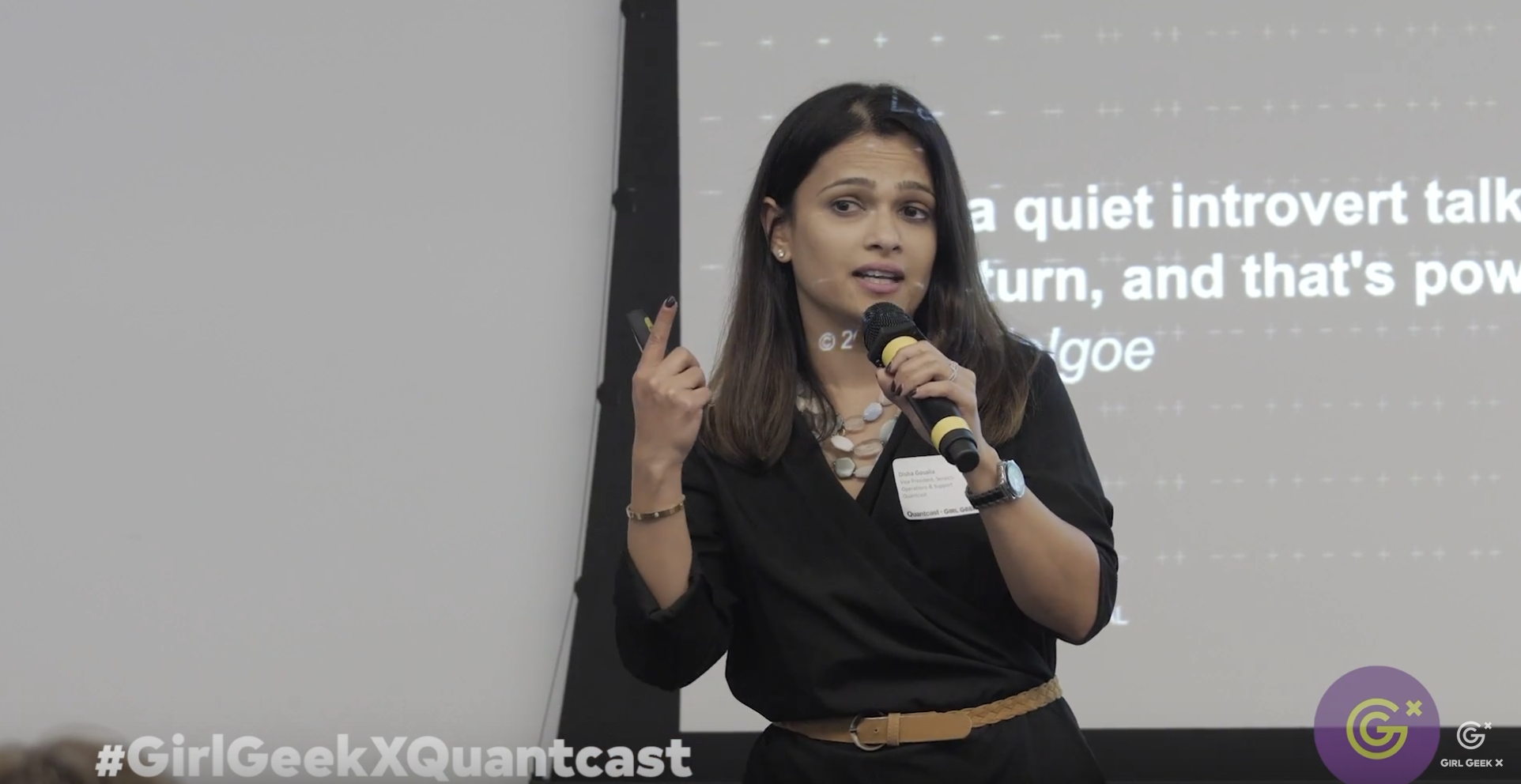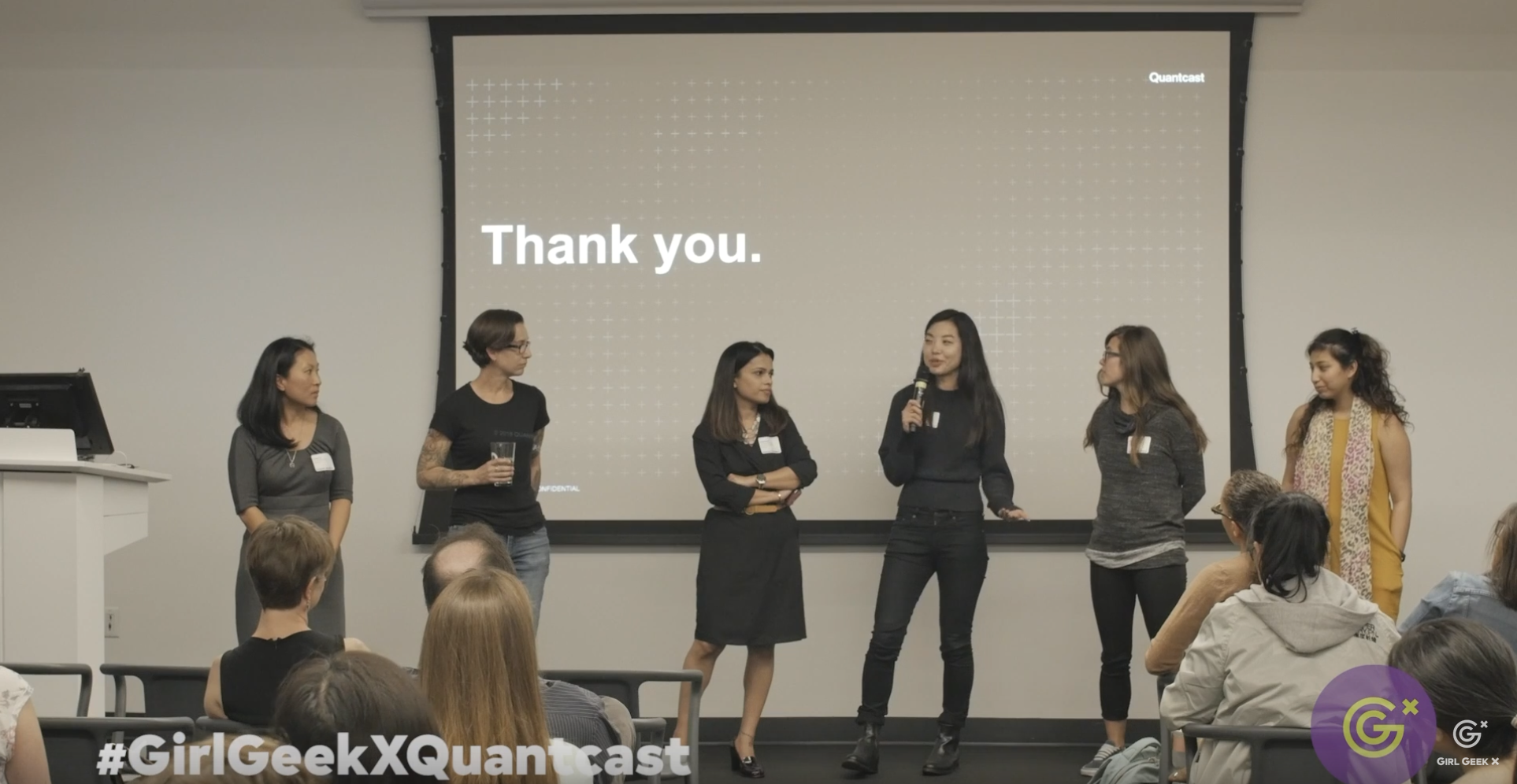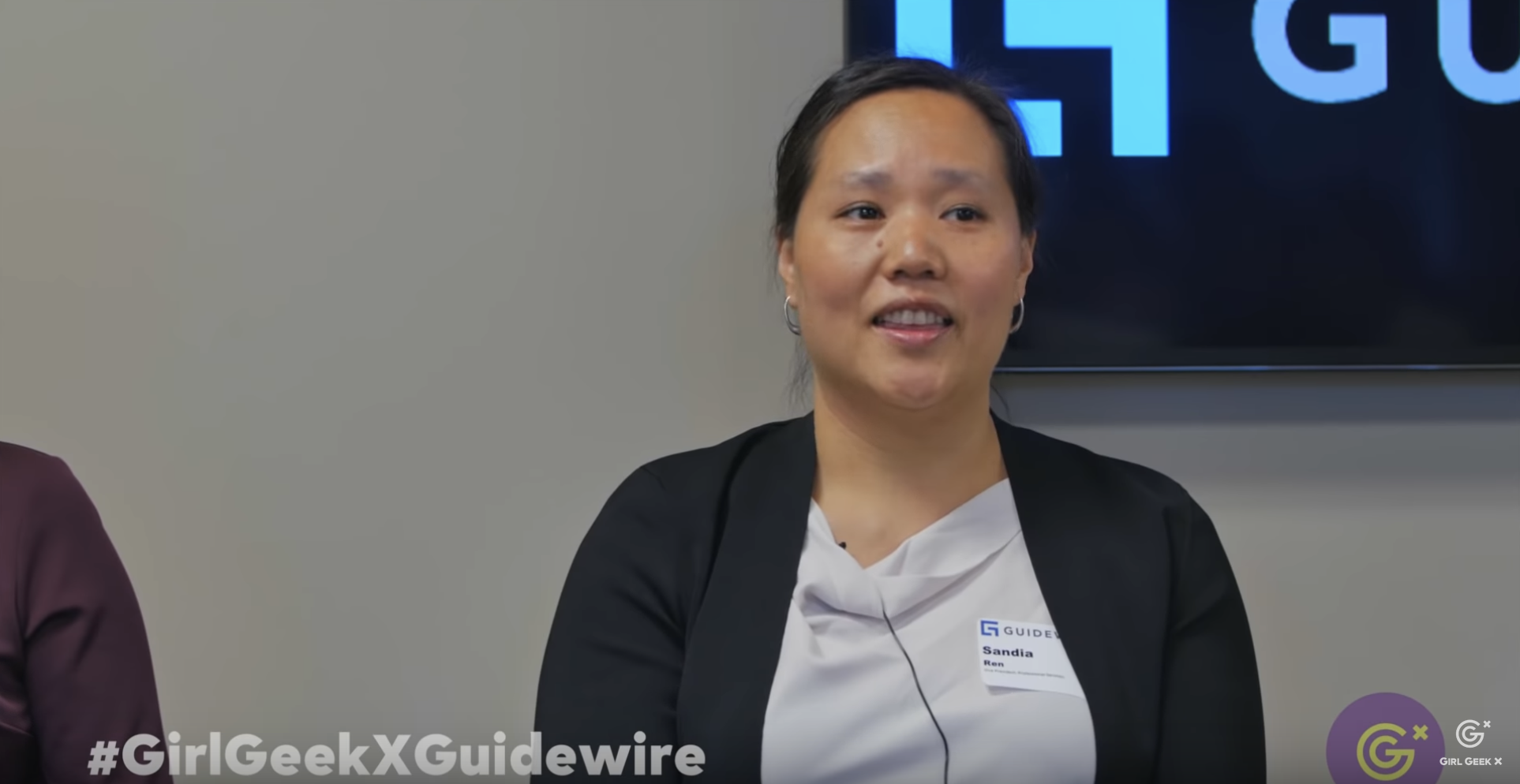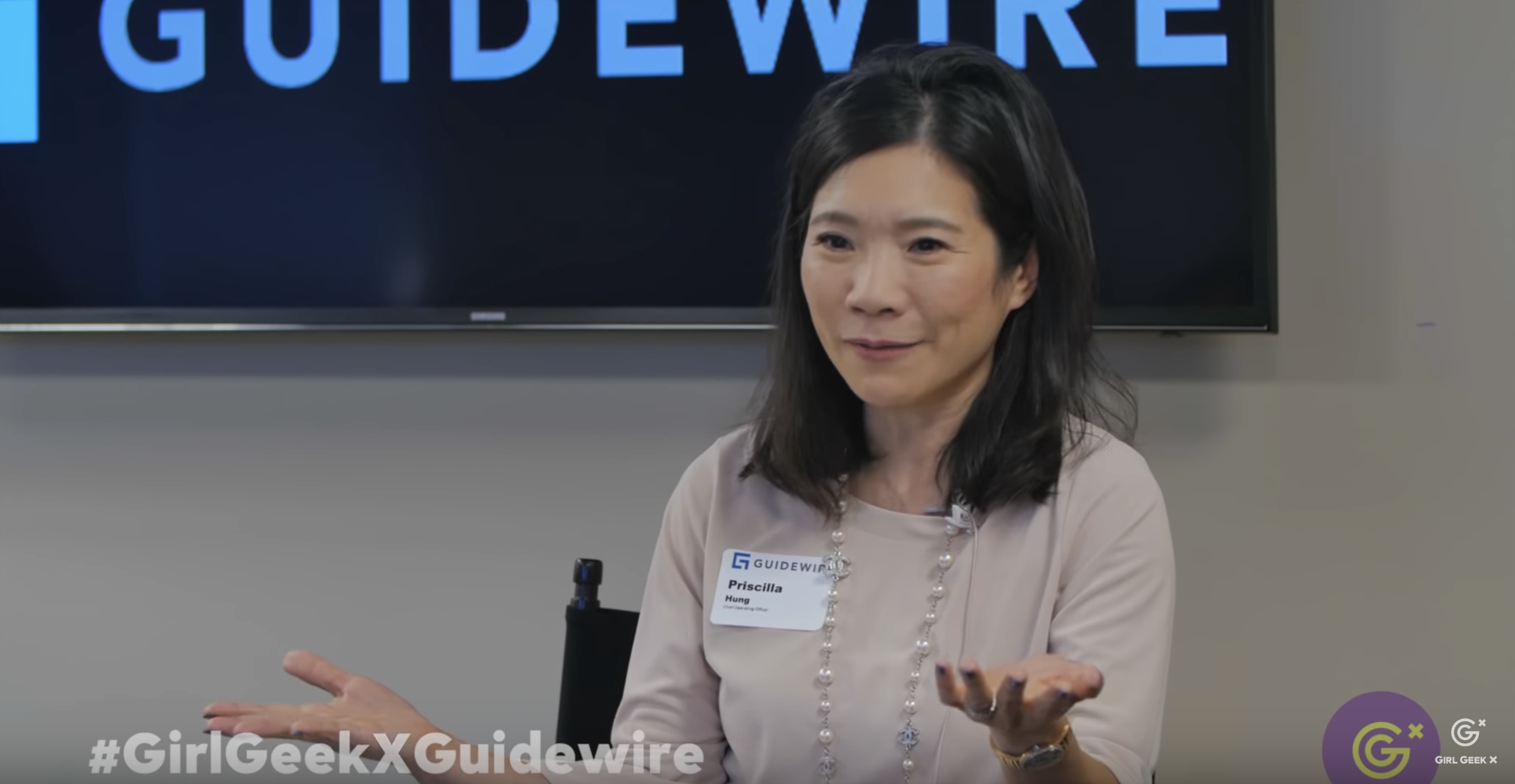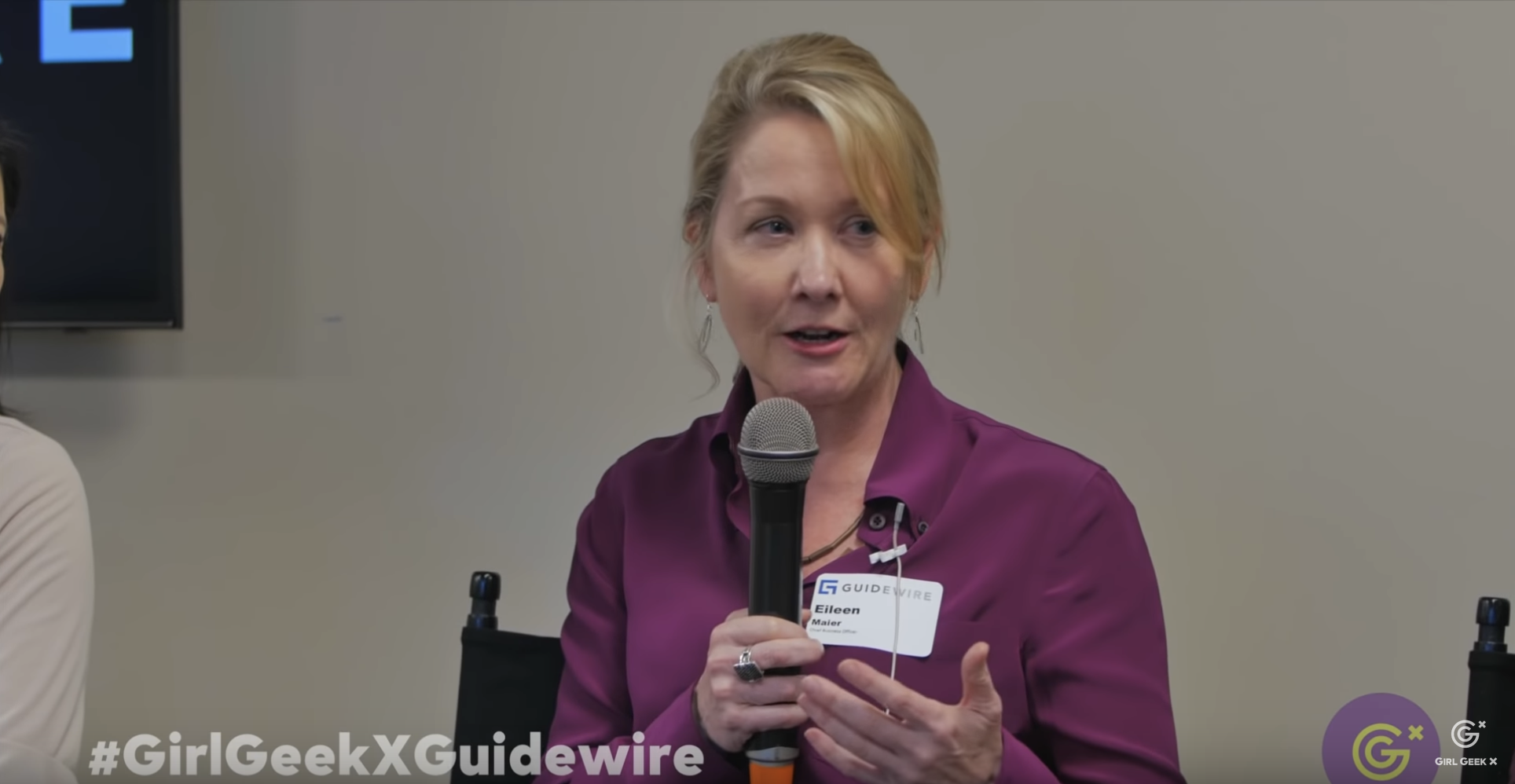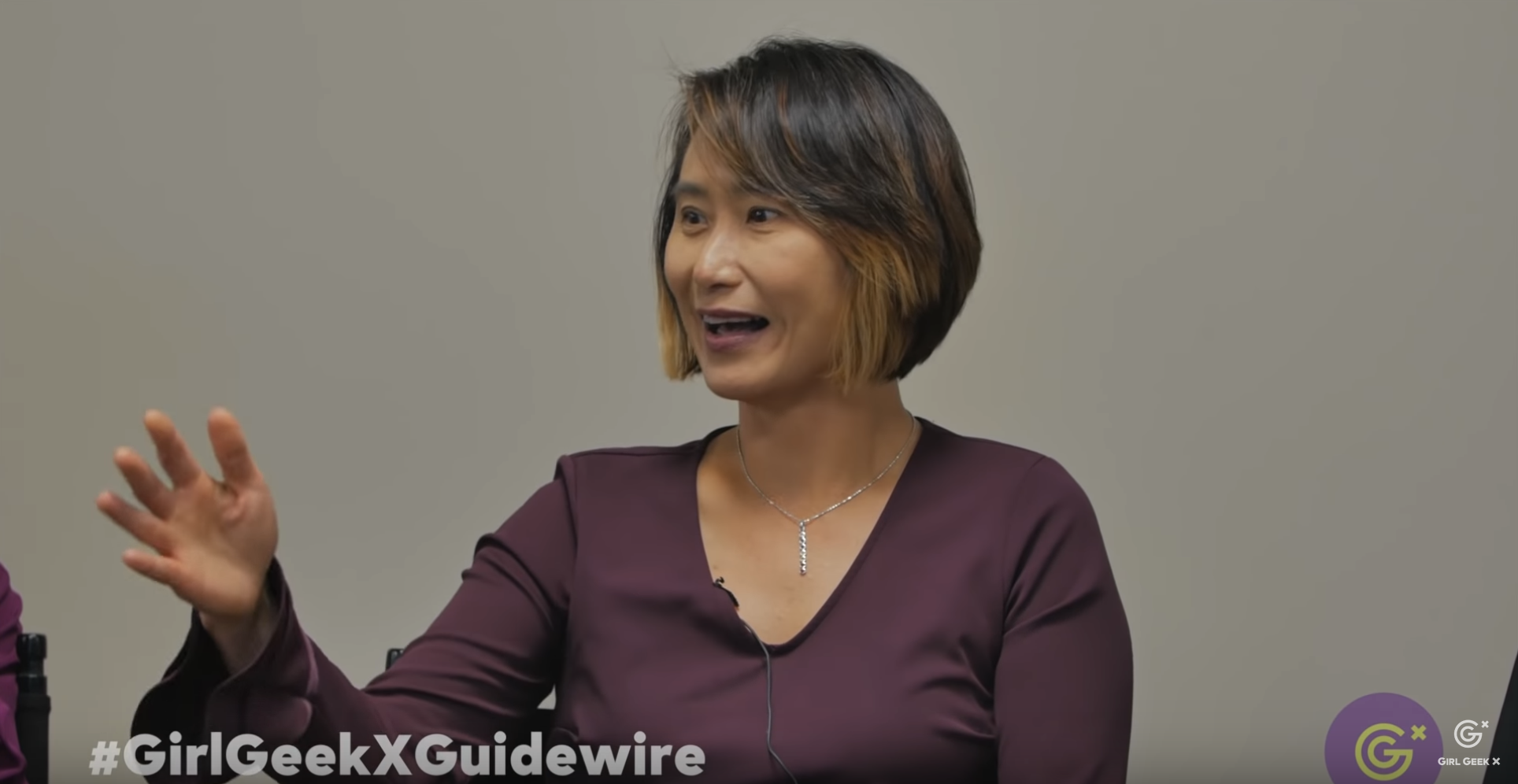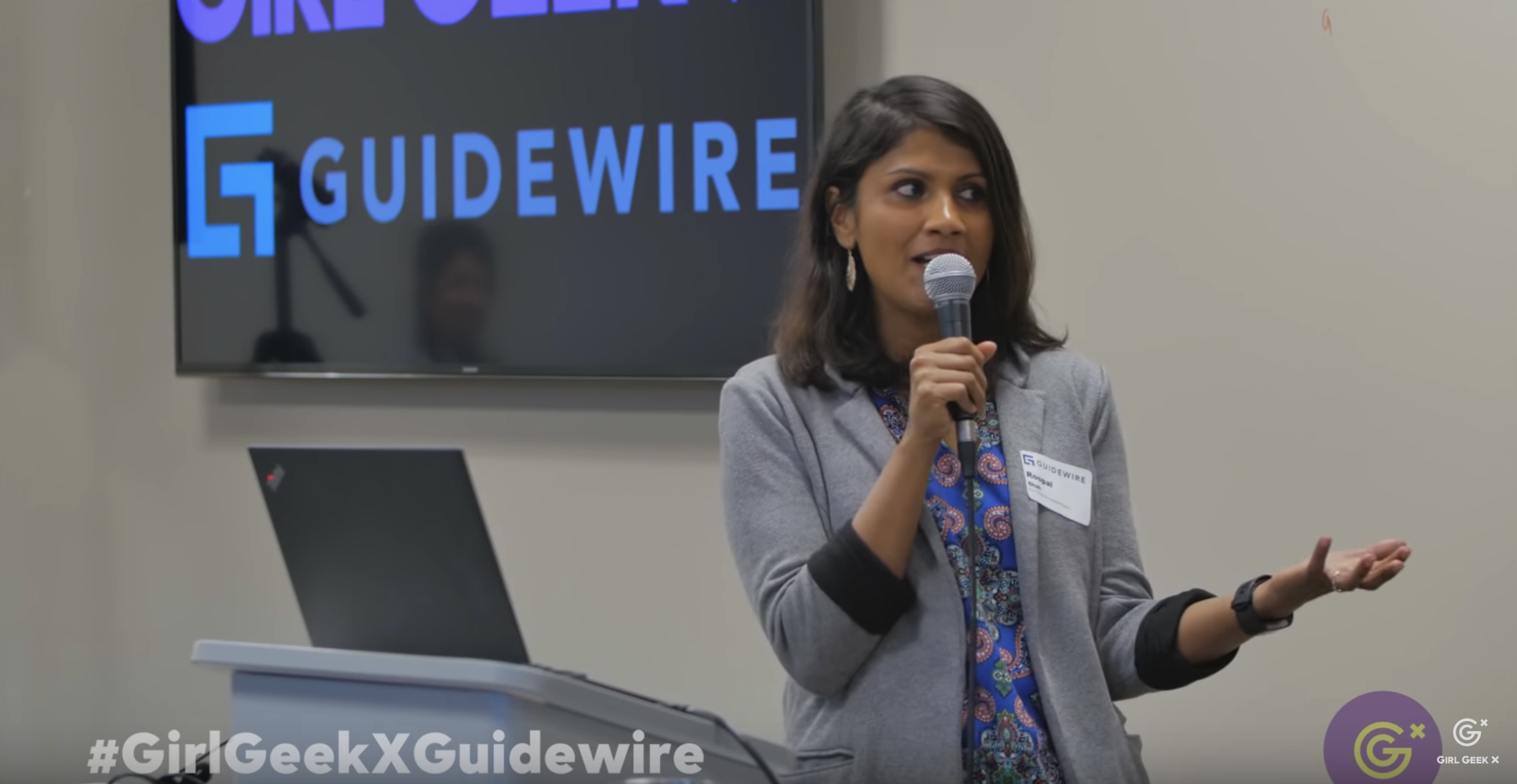Like what you see here? Our mission-aligned Girl Geek X partners are hiring!
- See open jobs at Care.com and check out open jobs at our trusted partner companies.
- Does your company want to sponsor a Girl Geek Dinner in 2021? Talk to us!
Speakers:
Connie Fong / VP, Marketing / Care.com
Sheila Lirio Marcelo / Founder, Chairwoman & CEO / Care.com
Abbey Stauffer / Director, Product Management / Care.com
Lauren Lee / Director, Product Management / Care.com
Rita Chow / Principal iOS Engineer / Care.com
Transcript of Care.com Girl Geek Dinner – Lightning Talks & Panel:
Connie Fong: Welcome everyone. Is my mic on? Good. Thank you so much for taking time out of your busy schedules to be here with us tonight. Hopefully you’ve had some great food, you’ve had some fun, and now you’re ready for some food for thought. If anyone knows me I’m always thinking about food, but if you don’t know me at all I just want to do a quick introduction.
Connie Fong: My name is Connie Young Fong. I will be your emcee for this evening and I currently head up the customer marketing engagement group at Care.com. I am also here to warn you that there will be a couple of gratuitous photos of our kids so be prepared for that and so why I don’t just get that party started. I am in the thick of back to school right now. This is Evan, my middle child. If you can’t see what he says, he says when he grows up he wants to be a dad. My social caption says, “He picked the second hardest job.”
Connie Fong: Moms, you know what I’m talking about. I want to give dads a lot of credit, at least one so, but the last time I checked we get the hormones, we get the weight gain, we go through labor and delivery so I’m a little biased, but in all seriousness being a parent is really, really difficult; taking care of your kids, taking care of your pets, taking care of your home. Dare I say making time to take care of yourself? It’s all really, really hard. That might be the understatement for the year. With or without help, it is really, really difficult, and since 2007 Care.com has really been the leading company to take on a lot of these care challenges, not just for families but also for caregivers and for companies and if you think about it, this has implications on our culture, within our society and also economies at large.
Connie Fong: This evening I’m very excited. We have a panel of amazing speakers tonight lined up to give you some perspective on how we manage two-sided marketplace and also share a little bit of insight into their personal journey. I just have one favor to ask of you before we start, is that we will save time at the end. Please make sure to remember your questions and we will have a more formal Q&A at the end of all the presentations.

Connie Fong: Many of us are here because we’ve been inspired by a woman named Sheila Lirio Marcelo. She is the founder, chairwoman, and CEO of Care.com and we’re very excited to welcome her tonight to be the first speaker within our panel.
Sheila Lirio Marcelo: Thanks, Connie. Super excited to be here. I have to tell you. Lately, I do a lot of public speaking. My team is always asking me, “Am I little nervous getting up here?” I am tonight. I think it depends on how much I drank, if I got enough sleep, depending on PMS, sorry we’re in a group of women, and whether I’m hormonal. That was my answer to them tonight, sorry guys, a little TMI. But one of the reasons I often now, when I public speak, I often accept speeches to actually speak at places with more men because I feel like oftentimes when I’m speaking to women where I’m preaching to the choir kind of nod their heads and said, “Yeah, I already know what you’re talking about. I go to that those women’s event and I know what you’re saying.”

Sheila Lirio Marcelo speaking at Care.com Girl Geek Dinner.
Sheila Lirio Marcelo: But when they asked me to come tonight, I was really, really excited because the challenges we have in technology Girl Geek, yes. It’s tough. There’s a lot of challenges that we face and I’m super excited to be in a room of super talented motivated women despite the challenges of the things that we face.
Sheila Lirio Marcelo: Today, I’m just going to talk about tonight on what drives each and every one of us and really breaking out into sort of purpose-driven life careers and what’s important and hopefully I can share a little bit about my story to each and everyone.
Sheila Lirio Marcelo: First off, I grew up in the Philippines, born and raised. It’s interesting, a lot of people don’t know it’s one of the countries with the narrowest gender gap. In the world economic forum reports actually of the top 10 up there with the Scandinavian countries with the narrowest gender gap, specifically in Asia which is interesting. It’s across the globe in Asia it’s … I went to Japan one year and I was speaking in front of women and many of them had worked in the Asian Development Bank and said it’s so amazing to be in a group of Filipinas because they act as role models.
Sheila Lirio Marcelo: I sometimes peel the onion that and thought about why is that because even pre-colonial times in the Philippines women were allowed to be priestesses, to play leadership roles, and they actually were also allowed to own property as sort of part of our culture and I only learned that recently when I went to college and decided I was going to come to the United States to go to Mount Holyoke and really study feminism. Because prior to coming to this country, I never really encountered biases which was really strange for me growing up in Asia. That actually, in the United States is really where I started to encounter biases especially as a female entrepreneur in technology.
Sheila Lirio Marcelo: Today, I thought I’d share with you something I think about that I think we all need to learn together, is that true journeys of strengthen resilience are actually built upon believing in ourselves and each other.
Sheila Lirio Marcelo: Oftentimes, we have role models in front of us and we think they’re heroes. We look up at them. What I always say it’s actually the people right next to you and the true authentic stories that make meaningful differences in our lives that inspire us. As women leaders in the workplace we can and must write our own stories and share them with each other so that we can lead authentically with purpose.
Sheila Lirio Marcelo: I always ask myself these three questions who, what, and how. It sounds pretty basic. I break it up to say who has influenced you? Many times we turn to our mentors. What impact do you want to have in the world? I meet with a lot of young people asking, “How did you end up at Care.com? What made you decide to start something like that?” Because there are very few companies that are mission-driven or purpose-driven.
Sheila Lirio Marcelo: I’ll talk a little bit about that and how do you stand for what you stand for, which is always tougher. The first question, who has influenced you and what lessons have you learned from them? I actually trace all my influences back to my beginnings and I try and take a little bit of stories of leaders that I run into to incorporate in my life as I met them along the way.
Sheila Lirio Marcelo: First, my parents. What’s interesting about us is that ,not surprisingly, one thing is that I have a type of mom, being raised Asian. I’m getting a lot of nodding. Yes, of course being Filipina, there’s a lot of role models of female presidents in government, a lot of female CEOs in the Philippines and nothing like … She always had to dream of sending her six kids to the United States for college and also pursuing professions because my parents were entrepreneurs.
Sheila Lirio Marcelo: Being Asian, we had designated professions. There were supposed to be the doctor, the dentist, the engineer, the lawyer, but God forbid no one should ever become an entrepreneur. My dad was actually a teddy bear dad. What did I mean by that? He’s the kind of dad who actually never minded ironing our shirts, taking care of us. He is a phenomenal cook. He’s also the kind of dad who would stand at the window or at the door. My parents live with me, to the point of driving away and he would stand there and wave until he couldn’t see me anymore. He’s that kind of dad. You could imagine that these were anti-stereo types of what we’re very familiar with, with gender and those are the parents that raised me.
Sheila Lirio Marcelo: But one of the best gifts that my parents gave me in influencing my life and answering that who is that, we came to the United States in the 1970s and I lived in Houston, Texas, for a few years and I then I forgot the entire language of Tagalog. I understood certain things, certain foods that were my favorite, but I completely stopped speaking the language because I came here at such a young age. My parents then decided that they wanted to raise us back in the Philippines and proceeded to send my older siblings to an American boarding school in the Philippines, but decided to send — I’m the fifth child and the sixth — my youngest brother to a province in the Philippines, a tiny little town that my parents were from so that I could learn the language all over again.
Sheila Lirio Marcelo: You could imagine a girl at 9 years old from Houston, Texas, saying “y’all,” going back to a provincial school in the Philippines, a very local school and being asked to stand every day to read a book in Tagalog in front of all these kids and how hard that was and embarrassing that was.
Sheila Lirio Marcelo: But why was that one of the best gifts in my life that year? Because my parents actually taught me the value of coconut. Like that is really strange, Sheila. Why? Because in the elementary school that we went to, every week we had to clear out all the chairs in the desk and each child was asked to actually help clean. I was responsible for cleaning the floors. I had to get down on my hands and knees and I learned to fall in love with the coconut because that would prevent me from getting down on my hands and knees because the coconut husk had a brush on it that made me sashay so that, I think my mic is still on, where I would literary do this and I’m really good at cleaning floors, really good now.
Sheila Lirio Marcelo: But what it actually taught me was not just hard work, but a sense of humility, responsibility and learning and also being so proximate to all these kids from all walks of life that I played on the streets with that year and to learn the language all over again. That probably was one of the most difficult years in my life other than getting pregnant in college and giving birth at a young age but that was really, really hard and that proximity that my parents taught me in a sense of identity of being Filipino was one of the most influential things in my life that drove purpose in my life.
Sheila Lirio Marcelo: Lessons growing up in the Philippines helped me create my own path, which is especially important after I got pregnant in college, as I mentioned. I started to veer from my parents’ plans. I wasn’t going to follow that designated profession, unfortunately. Tough for my tiger mom. And to think about it, my Catholic parents were very, very upset when I got pregnant between my sophomore and junior year in college and decided to get married and keep the baby.
Sheila Lirio Marcelo: My husband and I were pretty much on our own. My parents weren’t speaking to me. They didn’t expect sending me to women’s college would result in my being a young mother. They thought that men were not allowed on the campus at Mount Holyoke College. Lo and behold they were very surprised. Lo and behold, we have 26-year-old today who inspires us every day and I’ve been married 27 years, as of Friday.
Sheila Lirio Marcelo: During that time, my husband’s parents were also deceased. We didn’t really have a lot of access to resources. I just had friends from college who visit me recently and we caught up and I remember I disappeared my senior year of college in the sense that I was so focused on raising the baby with our son and we were struggling and we were poor and we just didn’t have a lot of help. That’s really inspired me later to start Care.com because I realized I wasn’t alone. But as our careers were taking off, Ron and I found ourselves struggling to balance work and family, really felt that pain.
Sheila Lirio Marcelo: And then fast forward when I was in grad school, another surprise pregnancy. Adam who is now 18, lovely gift, I call him. During that time, I decided after HBS that I would join an internet company, and again we needed help because the hours were so demanding that I asked my parents to come from the Philippines at this point. They were talking to me. They wanted to be a part of their grandchildren’s life. They came and then my father had a heart attack while he was carrying baby Adam up the stairs.
Sheila Lirio Marcelo: My father is alive today because I said he still waves to me from the window. He’s all healthy, but that was a big struggle for us because the whole point of my parents coming to the United States was actually to help care for baby Adam, and I found myself at 29 years old stuck between child care and senior care and I was also getting catapulted in my career at a young age to join a management team at Upromise, helping family save money for college and I didn’t have great care.
Sheila Lirio Marcelo: It was really hard and I was going home working at a technology company but using the Yellow Pages to look for care. Something really didn’t add up, which really led to the next question. When I decided to start my own business, I had to ask myself, what impact did I want to have on the world despite all the difficulty and challenges that I’ve faced so far. The second question is what is that impact?
Sheila Lirio Marcelo: Have you ever heard the expression, women hold up half the sky? Yes? Great book. I think that’s not the whole story, though because I actually think women don’t just hold up half the sky, we hold up the whole economy. I think that’s factual. I’m not just making a statement to be controversial. I think it’s actually factual. That’s why we’re so focused on improving the lives of women at Care.com.
Sheila Lirio Marcelo: If women and men worked equally, from the McKinsey study, the worldwide GDP would grow by $28 trillion or 26% by 2025. Apparently, that’s the size of the combined US and China GDP, if they were just equal. The single biggest obstacle to women’s equal workforce participation across the globe is balancing work and family responsibilities.
Sheila Lirio Marcelo: This is where then I found my authentic itself. Not only did I go through my difficulty, but lo and behold, a year after we started Care.com, my mother pulled me aside and said, “Did you know that the Philippines is the largest exporter of care around the world?” It suddenly started to add up, why I’ve had so many friends throughout my career, at this point I was still young, coming up to me saying, “I love adobo. I love pancit.” They would say, repeat all these Filipino words to me because some of them were actually raised by Filipino nannies.
Sheila Lirio Marcelo: As a working mother, I know the challenge to try and make everything work. The need of care is massive and it’s growing. It touches everyone when we think about the demand for care. I often describe the care economy is this: that if you think about young children, 90% of a child’s brain, 90% of it, compared to an adult brain is developed between the ages of 0 to 5.
Sheila Lirio Marcelo: We outsource a lot of this now from many dual income families because it’s about 70% dual income. If we’re outsourcing care, do we just think about physical care or should we actually care deeply about how that brain is developing in terms of the quality of care.
Sheila Lirio Marcelo: I remember once, I was speaking at a conference at Milken, a good friend of mine who was the head of finance in the Philippines, I didn’t know he was in the audience, so after I spoke he came up to me and said, “Sheila, I never even knew that. I better start paying attention to who I hire to take care of my children.”
Sheila Lirio Marcelo: People don’t pay attention to that fact that it actually drives and how much debate is there around how much we should invest in education because it impacts the competitiveness of our economy and overall society that if children aren’t learning a certain number of words by a certain age, it impacts them socially, economically, increases incarceration, a lot of these things impact our society and that comes down to care. It’s not merely just a soft issue.
Sheila Lirio Marcelo: Now let me fast forward it. If you’re thinking about the work environment, right now care is one of the most expensive items in the budget, up there with mortgage and rent. Many of you pay for childcare, some of you who are here tonight and you know what that cost like when you have to outsource it.
Sheila Lirio Marcelo: If you want to pay for great care, you got to work, right? You need great work to actually pay for great care. There’s sort of this codependency. Even in our middle period of our life where we’re working a majority of our lives, we also need care to work and vice versa.
Sheila Lirio Marcelo: Now, let me turn to the end of life, the economic argument for that. We know and we read it all the time in our newspapers, that the key driver of the, health, of the budget deficit is healthcare. We also know that what’s the key driver of healthcare cost. It’s actually end of life. We also know that most people want to age in place at home, about 90%, according to AARP.
Sheila Lirio Marcelo: If you want to age in place but you don’t have great care, why then are we surprised that the readmission rates are so high to hospitals and that’s what drives our healthcare cost.
Sheila Lirio Marcelo: Something so basic of not having great quality care for the elderly is also impacting our economy. I can go on and on, from early childhood and the competitiveness of our society and how we educate them and the quality of care to the work environment, to all the way to end of life and if somebody ever came up to me and said care was a soft issue that has no economic impact, I would look at them and be like, “How do you think about those things?” The reality is it does. Clearly, there’s a growing demand.
Sheila Lirio Marcelo: You’re sitting here in the audience saying, I didn’t have care tonight, right? How many of you have kids? Great. How many of you have nieces and nephews? How many of you have been kids? If you’re sitting here wondering, doesn’t ever apply to me. I don’t ever have to think about care. There is a senior tsunami coming and it will impact you, in case you hadn’t thought about it yet. When caregivers to go work, we all can go to work.
Sheila Lirio Marcelo: Which actually then turns to the issue about the supply of care. When my mom said it’s about the Philippines being the number one exporter of caregivers around the world, how are we also thinking about the supply care? On average, in the United States, caregivers are paid $9 an hour. Golf caddies are paid $17 an hour and that doesn’t include tips. The difference between what we value in caring our children to those that carry our golf clubs. Some of my male friends are so upset with me that I tweet about that, I write about that, and they said, “That’s really unfair that you describe it in that way.” I said, “How else can I describe it?” For people to open their eyes and say, “We have to think about the sustainability and the livable wage that is required for the care force so that we have a real care infrastructure that supports our entire society.
Sheila Lirio Marcelo: Now that we’ve talked about these things, we have a certain set of responsibilities to families and caregivers that we serve and to also to women around the world which leads me to the third question, I’m onto the third question. How do you stand by what you stand for?
Sheila Lirio Marcelo: Through the years, I’ve learned that the same old thinking will lead the same old results. I’m going to repeat this twice because I thought this is an interesting quote, “When you change the way you look at things, the things you look at change.” “When you change the way you look at things, the things you look at change.”
Sheila Lirio Marcelo: Most people know Care.com is a place to find child care or caregiving jobs. We use technology, certainly, to address universal problem and provide a better more efficient solution than the Yellow Pages or word of mouth. But what happens when we improve the efficiency? Is the problem solved? Are we strengthening families? Are we supporting women in the workforce?
Sheila Lirio Marcelo: When we zoom out, it was clear we could do more as a company, beyond making profit. We ask ourselves, do we stand by what we stand for and we kept building Care@ Work and now companies can provide family care benefits like emergency backup care so that we can have people show up to work and not stress out about it come to events like this.
Sheila Lirio Marcelo: HomePay, household tax and payroll services so that caregivers can be paid legally and be paid above minimum wage. Then they get access because as we know in the future work the gig economy is struggling. We need to make sure that they’ve got a social net access to social security and Medicare benefits and unemployment insurance.
Sheila Lirio Marcelo: Then we also launched Care.com Benefits. We provide access to caregivers to have pooled portable benefits, access to healthcare, workers compensation that I mentioned, savings account, budgeting tools, a lot of things, because where we’re headed with the future of work, there aren’t the institutions anymore for gig workers that provides them the access to a social net.
Sheila Lirio Marcelo: But we can’t do this alone. I always say building a care infrastructure takes a village and there’s a lot that we’re doing, partnering. As an example, we’re training refugees in Europe to be caregivers but we’re not doing that by ourselves. We’re partnering with International Rescue Commission and Rockefeller Foundation. We’ve launched the Care Institute as a 501(c)(3 )to train caregivers around the country and hopefully the globe and we’ve done that we’ve AARP, as well as Boston Children’s Hospital and I can go on. So many different things that we believe is a responsibility because it’s more than just actually creating profit and leading life with a purpose. There are always moments where what we value is challenged.
Sheila Lirio Marcelo: Quick story, it was really hard, and this isn’t about my personal politics, but in 2016 certainly the result of the election was shocking. I was at Javits. I was very emotional at night. It took me about a week to speak in front of the company. There were a lot of issues going on the company. We have a lot of women in the company disappointed that we did not have a female president as a result.
Sheila Lirio Marcelo: I only shared this story because I have to set aside my personal from running a public company. It took me four days to get in front of the company and stand, and the way that I spoke to them, I stood one side and I said, “You know what, this is Sheila upset.” I was in tears. I couldn’t even hold it back. It took me literally four days before to even come up with the words to speak in front of the company. I stood over here and then I said, “This is Sheila as the public CEO telling you guys you cannot blog about how upset you are because we serve the entire country in the world and people are watching us.” We have to set our personal stuff aside and that’s very difficult to do.
Sheila Lirio Marcelo: But the reason I’m sharing this story with you is because two weeks later, I had to go and have a dinner with Ivanka Trump. After all that emotion that I had to go through, because she decided she was going to carry the torch around childcare and childcare tax credits. Guess what? I’m the Care.com CEO, the largest platform for care in the country. I had to go to that dinner and represent what’s right for families and caregivers, setting aside anything. I actually found in that dinner was my own biases that was at fault, and I was being too judgmental. I share that to say that sometimes we really have to push ourselves to figure out and set our personal over what’s important.
Sheila Lirio Marcelo: Then two weeks later, we were also challenged with immigration ban. Then I had to ask myself, “Okay, I feel like a ping pong ball. I feel like I’m depressed over here. I got to go pull it together for this dinner, and then I’m going to sign a letter and want to be the first CEOs to sign a letter on immigration ban, just when I’m trying to develop a relationship with this administration?” I mean, what the hell. I mean it’s tough figuring out what you stand for. It’s challenging in leadership. It’s not easy but constantly questioning the values. I’m still proud that we signed that letter and also really supported DACA and the children that were split from their parents just so much.
Sheila Lirio Marcelo: Look, in closing, I’m up here talking about values. I’m up here trying to share my own personal story and people always ask me what makes you tick? I get a little emotional because at the end of the day it’s actually just being human. It’s about the people sitting next to you and listening to their stories, giving them that certain level of respect because everyone has a story. Everybody, not just me. Those were the true stories that should inspire you because that’s often those people challenges and it doesn’t matter what level of success you’ve achieved.
Sheila Lirio Marcelo: I have the same equal difficulties and challenges that everybody has because it’s about being human and so it’s those authentic stories that we should really rely on and turn to each other so that when we learn about those journeys, we ask ourselves, who, what, and how. Thank you for having me. I’m super excited for you guys to meet our female leaders and I’m looking forward to answering any of your questions. Thank you.
Connie Fong: Thank you so much, Sheila. It feels really good to work for a mission-based organization where it truly is founded on love. It truly is founded on caring for people and that is always good. The other thing that’s always good is actually figuring out how to make some money and to actually be profitable. Next up, we actually have Dominique Baillet. She is our Senior Director who heads up our growth and product development team, and the one thing that’s fun about Dominique is she didn’t show gratuitous photos of her daughter in her interview. She literally brought her daughter to the interview at three months. Suffice it to say she got the job. We’re very excited that she’s here with us tonight.
Dominique Baillet: Thanks, Connie, and hi everyone. It’s not easy to follow Sheila but I’ll do my best. Today, I’m here to talk about how to monetize online marketplaces, which is really important to building a sustainable business. This is something that I’ve thought about every day for the last five years.
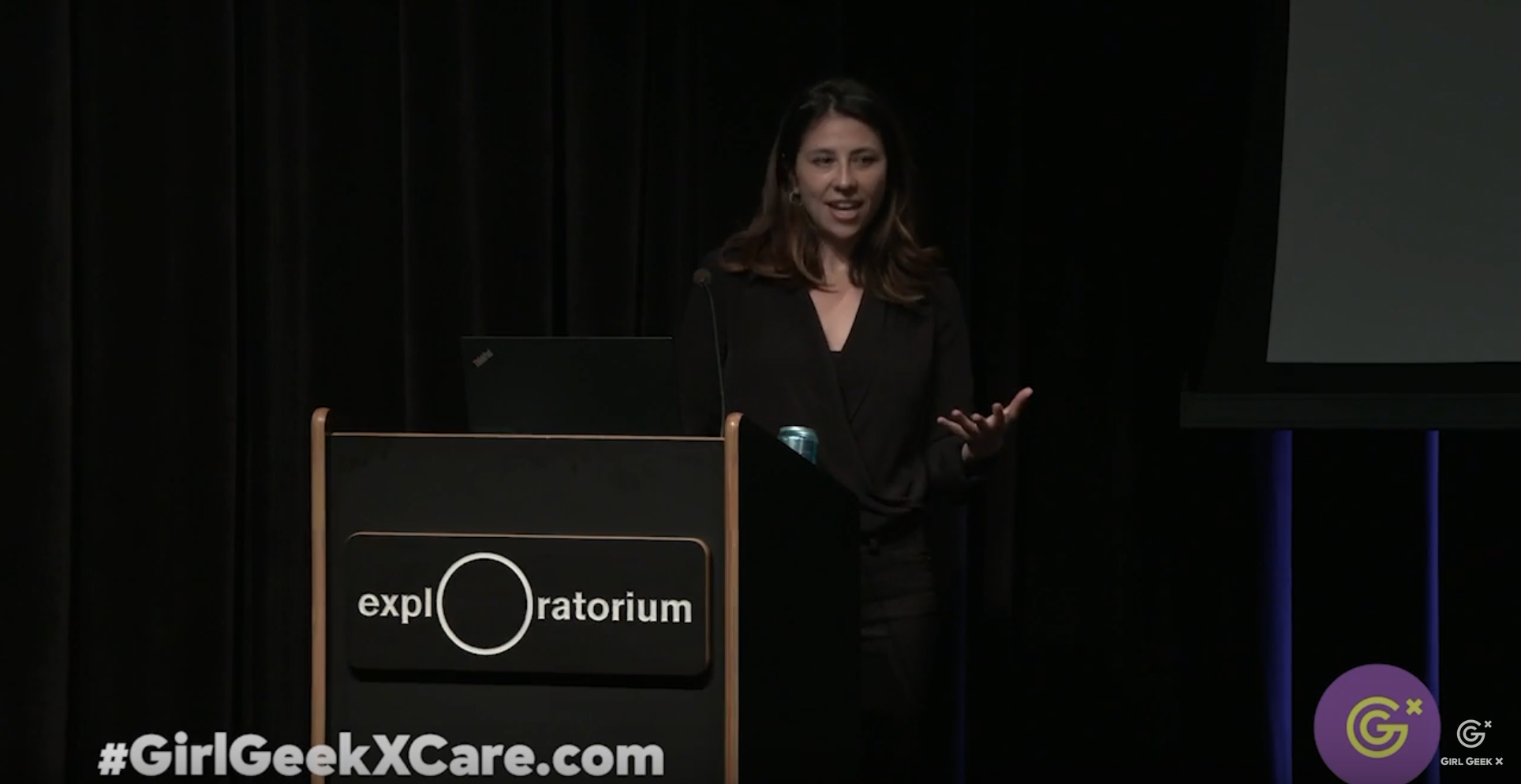
Dominique Baillet speaking at Care.com Girl Geek Dinner.
Dominique Baillet: Today, as the head of growthforcare.com where I’m responsible for bringing more members onto the platform and having them become subscribing members with us. Before that I led business operations for growth and new markets at NerdWallet, which is an online marketplace matching consumers with financial products. This is something that I’ve thought a lot about.
Dominique Baillet: First, it’s important to set the stage. We are living in the golden age of consumer technology. The stock market has been booming. There’s been a lot of investor funding going around and we as consumers have benefited from all of this easy money and it’s been great. I didn’t even know how delightful products could be until Snapchat came around and showed me that I could take a picture of my daughter, airbrush her, put on these funny glasses and freckles and I would fall in love all over again. Or how about, I don’t know if you guys remember the time when Uber was offering rides across the city for $2 or when Instacart was first giving out free grocery delivery, all of that consumer delight was funded by this easy money and these companies grew a lot because of it. But it hasn’t always been sustainable to grow in that way and there’s actually a downside to this unfettered growth.
Dominique Baillet: Case in point, are of you guys MoviePass subscribers? Anyone? Are you guys still MoviePass subscribers? You are? Okay. That’s great. They need you. Yes, well what an amazing product and value proposition, $10 a month to see as many movies as you want, it was incredible. They vastly exceeded their user growth expectations, but they really couldn’t continue to service that. While MoviePass isn’t quite dead, obviously, it is dying.
Dominique Baillet: The lesson here is that while we are so focused on growth that it’s also important to balance the idea of how to actually make money. You don’t have to optimize for making money but you absolutely have to have a plan for it before this easy money dries up.
Dominique Baillet: In a one-sided marketplace, growth and monetization are a little bit more, go a little bit hand in hand. You make a product, you sell the product, you sell more of that product, you make more money. It feels like you grow, you make money, great.
Dominique Baillet: A two-sided marketplace is a little bit more complex. Not only do you need to actually grow both sides of the marketplace, buyer and the seller side, but there’s even a question of what your product even is. Is your product the platform? Is it your sellers? Is it your seller’s products? Is it access to the buyers or is it the underlying user behavior data? Only once when you figure that out can you actually think about how to make money.
Dominique Baillet: If you currently work at a marketplace business or if you’re thinking about joining a marketplace business, there’s three simple questions you need to understand to fund the basis of a monetization plan: who pays, what do they pay for and what do you give away for free.
Dominique Baillet: First, in terms of who pays, you’ve basically got three options: you’ve got the buyer, you’ve got the seller and you’ve got a third party. The key considerations you really need to think about is, who benefits the most from this marketplace and who is willing and can actually afford to pay.
Dominique Baillet: The next question is, what do they actually pay for? If you think about it, a marketplace is still fundamentally a place where someone is trying to buy something or find someone, and so as a marketplace, you really need to think about where you add the most value in that, in creating value for your end users and that can be represented by a nice funnel here.
Dominique Baillet: As a marketplace, you can think about is the value you’re adding actually at the top of the funnel creating access. Think about when Etsy started. It enabled these micro-entrepreneurs to actually open these store fronts, giving access to buyers everywhere of crocheted products. Or think about LinkedIn and the access it created of enabling recruiters to post a job that would go anywhere. That would be creating value in terms of access. The mid funnel is all about leads. Is your marketplace actually set up to curate a set of products or curate a set of love interests and is your value really in the vetting process.
Dominique Baillet: At the bottom of the funnel is transactions. Is your marketplace actually set up to shepherd someone to actually make that sale or make that match? Is that the differential value you’re actually creating? These are things to think about when you think about what are you going to actually ask these payers to pay for. Then lastly is the question of what do you give away for free? Free is really what you when you’re trying to acquire users or when you need the marketplace itself to work. Everything outside of that is really a distraction when you think about what you’re giving away for free.
Dominique Baillet: To bring this to light, I wanted to give a few examples of how these three questions are really interrelated. At Care.com, we monetize primarily on the buyer side or the family, so families like mine. When I was looking for a nanny for my daughter, Greta, I had two not great options. One, very expensive, I could go to a nanny agency, spend thousands of dollars. The other option was incredibly time consuming. I would have to source a number of high quality caregivers and vet them myself and interview and do all of that. Care.com actually created a ton of value in saving me both time and money.
Dominique Baillet: On the other side of the marketplace, the supply side would be the caregivers. Caregivers are in job searching mode, don’t have a job and maybe have less disposable income if they’re looking for a job, and then also job seeking markets, and typically the job seeker doesn’t actually pay. At Care.com, it’s really the families, that buy side.
Dominique Baillet: Then what families, what I was looking for, was really access. When I was thinking about finding a nanny, it wasn’t like an Uber driver where anyone could do. I really needed to have a good personal connection. Having access to a base of high quality caregivers that I could really figure out who is best for me and my family, that’s really what I was paying for. I was paying for access to that market.
Dominique Baillet: In terms of what’s free, as I mentioned, Care.com is really only successful if we have the best and the most caregivers. Therefore, we made the whole caregiver experience free. It’s free to set up a profile. It’s free to get a job and really what we’re trying to do is get as many of these great caregivers onto our platform. We don’t want to create any friction there.
Dominique Baillet: We also need the families, the payer side, to have confidence in the platform and to understand that inventory we say we have is true. We also make it free to post a job and free to search the caregiver so you really understand that Care.com is what it says it is.
Dominique Baillet: NerdWallet is a different marketplace, has a different strategy, and as I mentioned, NerdWallet matches consumers with financial products. In terms of their evaluation of who pays, that one’s is pretty easy. It’s the sell side who pays. Those are the financial institutions like Chase or Citi or Bank of America. They have a lot of money that they put aside toward customer acquisition and are always looking for new channels to make a sale, to find a customer. They have the money. Meanwhile, the buy side of that marketplace, consumers, like you or I, we can really go almost anywhere to get a credit card these days. We’d never pay for that service.
Dominique Baillet: In terms of what the financial institutions pay for, it’s really at that bottom of the funnel, it’s that transaction. For NerdWallet, it’s credit card business. We would monetize on the transaction and the NerdWallet experience from providing advice, to tools, to making the credit card application process really easy, was all targeted toward helping consumer get the product they want, helping the seller make the sale. Then finally in terms of what’s free, like I said, people can go anywhere to get credit cards, so why would they actually come to NerdWallet? In order for that marketplace to really work, we had to have the consumers. Therefore, NerdWallet invested a ton in great content, in tools, in order to build that trust with users.
Dominique Baillet: I know it’s hard to go through three examples but for the sake of comprehensiveness, I want to talk quickly about Facebook, which I’m sure everyone here is quite familiar with. In terms of who pays for Facebook, it’s really third party ads. No shocker there. Marketers are paying for access and leads in the form of eyeballs and click-throughs and in terms of what’s free, well think about what is it take for that marketplace to work, it really requires having very detailed user information. The product is the social medial platform we’re all quite familiar with.
Dominique Baillet: Facebook also invests in a number of marketing tools, for marketers to get the most use out of that ad platform. The lesson here is these three questions are interrelated and every business has a different business model where you really need to think about who pays, what for, and what’s free.
Dominique Baillet: If I’ve exposed for you in this conversation that two-sided marketplaces are complex, I hope that you also feel a sense of excitement in that complexity. It’s really a game of chess, not checkers and there’s a number of strategic choices that can be made.
Dominique Baillet: If you find yourself building a marketplace business, just remember that growth is important, but make sure you have a plan for making money. Consider who pays, ensure you’re offering them differential value and that they can actually afford it. Know what you’re asking people to pay for and make sure that you’re aligning the value you offer with the value you create.
Dominique Baillet: Lastly, have a plan for what’s free because nothing in life is free. Make sure whatever you are giving for free actually reinforces your marketplace. Thank you very much.
Connie Fong: Nothing in life is free. That’s the second understatement for the evening. Next up, we actually have Abbey Stauffer. She is our Director of Product Management, and she actually manages all of the matches within our site experience. She truly is the matchmaker on our site. Here, she’s also going to give a talk on the art and science of matchmaking.
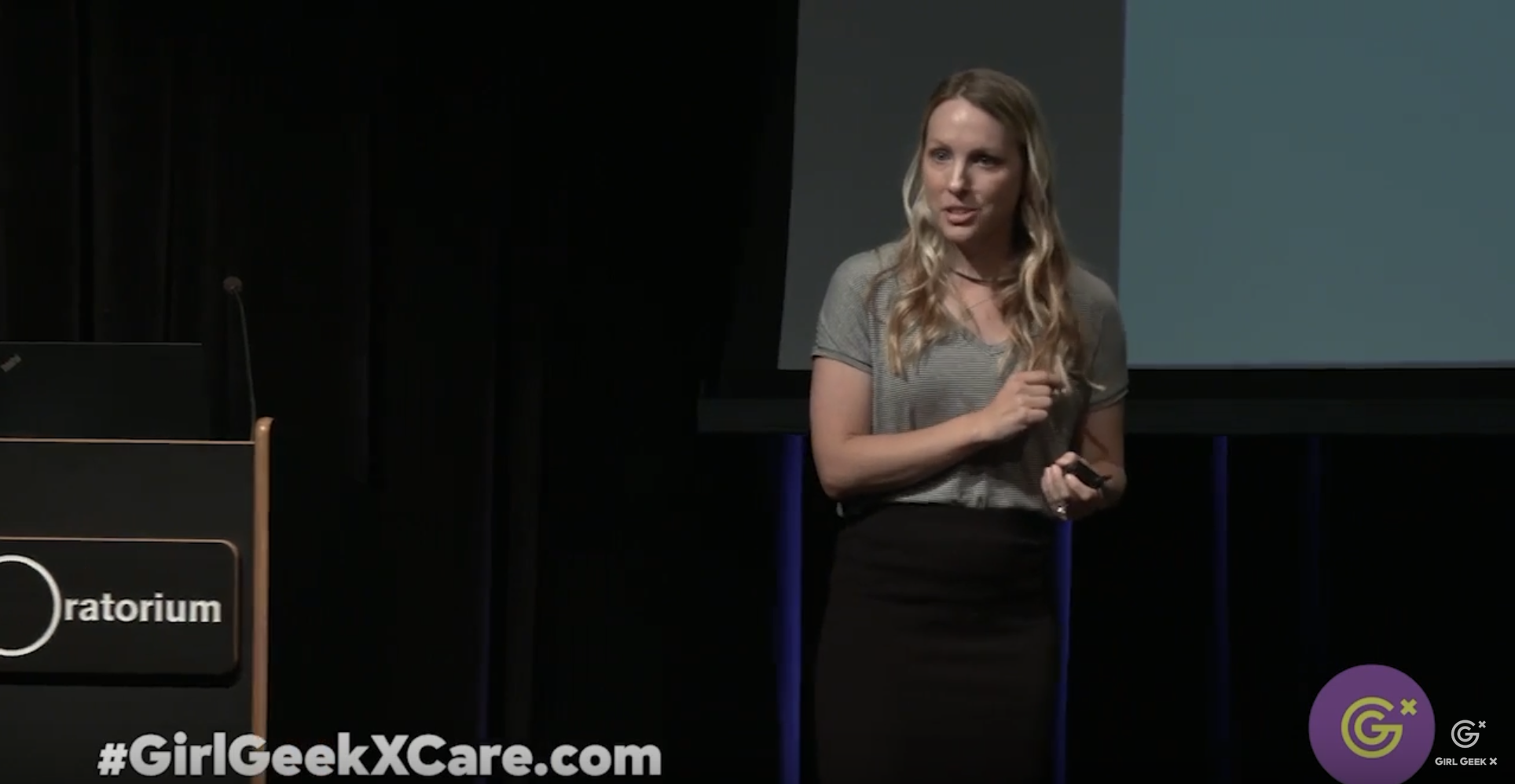
Abbey Stauffer speaking at Care.com Girl Geek Dinner.
Abbey Stauffer: That’s me. I have an important question for you guys. Does anyone here ever feel like Netflix knows you? Yeah? I’m not the only one? The first time I watched Gilmore Girls, I was like, “Oh my God. Thank you, somebody knows me.” Someone can see into my soul by recommending the Gilmore Girls. I love this show and it came to me as a Netflix recommendation. Now, of course that didn’t happen by accident and I think probably being here in Silicon Valley, most people understand that Netflix has invested really heavily in their matching technology. They put millions of dollars and many, many years of work into making the recommendation engine what it is today. Guess what? Their work will never be done. They will never have a recommendation algorithm that is complete.
Abbey Stauffer: I think that’s fascinating. They take hundreds of millions of data points in order to match me up with this wonderful show. They’ve actually even invested further than just their own team. They famously declared the Netflix prize, which was a million dollar prize for anyone who could improve the algorithm by just 10%. That’s pretty crazy and somebody won that, but we’ll come back and talk more about that later. Netflix, they take a ton of data and they give you a recommendation. That in itself is a pretty complex and challenging thing. But in this equation, only I have to like Gilmore Girls. Gilmore Girls doesn’t have to like me back, right? Warner Bros. doesn’t have to want me specifically as a viewer.
Abbey Stauffer: That is the challenge of a two-sided marketplace. When you’re serving the needs of two users, you’re matching challenge gets ever more complex, and that’s what I get to work on every day with Care.com. We are stewards of not only the families that we serve, but also the caregivers and guess what? The needs on the caregiving side are just as complex as they are for the family.
Abbey Stauffer: While I love this match and I think it was perfect for me, at Care.com we get to work on a two-sided marketplace, two-sided match, and I’d love to share with you more about what I do day-to-day in that matching process but also share some other matching methodologies and challenges that I see all around us.
Abbey Stauffer: Matching challenges are not just an online thing. They exist in the offline world. They exist online. They’re old school. They’re new school. Think about organ patients waiting for a donor or medical residents waiting for a hospital match or even the entire college admissions process.
Abbey Stauffer: Now, all of these things, they are matching problems, and they haven’t moved entirely online, but they do leverage matching methodologies. We won’t go into the specific algorithms today but each one has kind of a unique way or unique ways that they leverage algorithms. I encourage you to check up on that. Certainly here in Silicon Valley, we have matching challenges abound. We have full industries that have popped up around getting people to a great match. Looking for love, a whole industry around that. I can’t even keep up with it. Every time I turn around there’s a different app. Looking for a ride. This is super interesting, actually, Lyft has an engineering blog where they give you a ton of information about what they’re working on, things that they’ve tried, challenges that they’ve experienced and they’re really forthcoming with what they’ve done so you can learn a ton from reading their engineering blog and others.
Abbey Stauffer: When they started out, the matching challenge was relatively straightforward, although I’m sure if anyone here works at Lyft, you’d probably disagree with because it took it probably a ton of work to get there, but they were matching one rider with one driver, right? Take a rider, match them with a driver who is nearby and available. Not that hard, right?
Abbey Stauffer: Well, the company was not satisfied with just that match and just with the status quo of their business. They thought, how do we make the service even cheaper for our users? How do we grow our ridership? They started to think about how they could add more people to the ride, how they can add more riders into the match, and this is where things I think got really interesting with their matching challenge.
Abbey Stauffer: This, as you can probably tell, is what precipitated their Lyft Line product when they have multiple riders sharing one driver. At first, they had an algorithm that was serving one additional rider, so two riders to one driver. The algorithm that they had came up with four different, that’s three, four different route permutations, then had to declare the winner for and match up the rider and the driver. That started to go well. Users were responding to it. It was a service that was really taking off. Being in Silicon Valley and being an ambitious company, they didn’t stop there. They added a third rider and a fourth rider, and as they got to that fourth rider, the algorithm was then catapulted from giving them four permutations of a route to 1700. That was their challenge, right, to narrow that down come up with an optimized match from 1700 possible route permutations.
Abbey Stauffer: Now, if that makes any of you feel like you’ve been watching Westworld for too long to think about how to solve that product challenge with an algorithm, then I’m totally with you. I’ve been there. I live that on the regular in the matching world, but don’t worry, there are a number of what I would call foundational things that you can think about if you’re getting started in matching.
Abbey Stauffer: Many of you probably already worked on matching challenges or maybe you’re interested in getting into it and so I’d like to spend the rest of the time talking about what I think are four key things to think about. I need a drink of water. Okay.
Abbey Stauffer: Probably unsurprising to all of you, but you will need data in order to match up users. Data can take all sorts of different forms. Of course, you’ll have your user data, the data that they give you into their profile. This is the most straightforward kind of data to collect. But you can also look at behavior data.
Abbey Stauffer: What the user does and what they tell you is often very different. My favorite example of this is Match.com.
Abbey Stauffer: Does anyone follow Match.com’s findings that they’ve released in the media kind of like Okcupid did, as well? Okay, well, a number of years ago, they took a look at their data and they saw conservative men want to date conservative women. It makes sense, or at least according to the dating profile. Then when they took a look at the user behavior, they found that the conservative men were actually spending a curious amount of time looking at liberal women’s profiles.
Abbey Stauffer: Now, that is a fascinating product challenge right there. I have no idea what they did with it. I have no idea if they put it into the algorithm or if they just decided not to touch that with a 10-foot pole, but I would have love to be there for that product conversation to think about how you pair the data of what the user does with what the user tells you. Oops. Okay.
Abbey Stauffer: Triangulation data. What I mean by this is really looking for external data sources. This can be really useful for those of you that work in more nascent products or new businesses that don’t yet have scale with your data. You can also look at triangulating data from users that are similar to the user that you’re interested in solving for.
Abbey Stauffer: Then finally, success data. This is often overlooked at the start of a matching project. Your algorithm is not going to teach itself, people. Well, it will eventually, but only if you’re giving it success data. You have to give it the information about when it makes a successful or an unsuccessful match. You have to train it and coach it and coax it until it is matching on its own.
Abbey Stauffer: You need to have a metric of what success actually is and that’s a lot easier said than done in many cases. If you don’t own the full fulfillment of your product, if you hand it off to a third party or if your users decide to take things offline and not complete on your platform, then guess what, you’re not going to have that success metric.
Abbey Stauffer: What do you there? You could think about intermediate success metrics or indicators of a good match or you could align as a company on a different success metric and that will probably take quite a lot of internal conversation to agree upon something like that. Just a few types of data. There’s many more that can serve your matching needs.
Abbey Stauffer: Unfortunately, that data could be collecting dust if you do not have a strong data engineering group or data warehousing group. Think of it as a sort of hierarchy of needs, the pyramid about needing food and shelter before you can have self-actualization. The same could be said for data. Okay, first you need the data, you have to capture it, but if you don’t store it in the right way, if you don’t structure it in the right way, that makes it consumable for an algorithm. It’s just going to be collecting dust and maybe your dear data analyst will be able to get some insights for you, but you won’t be able to use it in your matching methodology. Having a strong data engineering team, data warehousing team is key.
Abbey Stauffer: Okay, this brings me to my next point, thought partnership. We’ve covered the science of matching and now we move on to the art. Thought partnership is a key part of being a product manager, right? You have to have relationships with all of the different groups in your company and you have to engage them and get thought partnership from all of them in order to arrive at a good product solution.
Abbey Stauffer: A couple of examples here, who you need to partner with will very greatly by your product and what you’re trying to achieve, but a couple of examples. Your business analytics partner can do a lot to help you keep grounded in sound methodologies and keep you honest if you’re trying to extract a takeaway from some data that’s not actually true, to keep you honest there. And engineering can help you think about building an algorithm that will scale with your product, because, hopefully your product is poised for explosive growth and your algorithm will need to grow with that.
Abbey Stauffer: They can also help you think about building your algorithm for speed to make sure that you are actually delivering the recommendation to the user as fast as you need to. The Netflix Prize that I told you about before, they did award a winner. It was a team of a few people and they got their money, but Netflix never implemented the algorithm because the engineering costs do so was so high. That just underscores the need for both thought partnership and the strong data engineering foundation because having a huge fancy algorithm is not always easy to actually implement and scale with your company.
Abbey Stauffer: User empathy, last puzzle piece. Having a feedback with loop with your users to make sure that they agree that the match is successful is hugely important, and Lyft, we’ll go back to that example. They’ve done a great job at this. They took the time to actually incorporate a feedback loop into their product.
Abbey Stauffer: What they’re hearing from users was, even though the match that they had in the multi-rider match scenario was getting them to the final destination quickly, they hated backtracking, that was the main takeaway. “Please, get me to my destination quickly, but do not make me backtrack and God forbid, don’t do it on a highway.”
Abbey Stauffer: What they found, really, was that users valued having a direct path more than they did, having the fastest path. What a fascinating thing for them to find. Then their task became, how do we bring that back into our algorithm as a success metric and they never would have gotten that if they didn’t have a feedback loop that built into their product or if they didn’t take the time to actually sit down and talk to their customers.
Abbey Stauffer: Obviously, a lot of art and science goes into matching. I love my job because I get to work on that problem every day. This is my favorite match of all. I was a part of a nanny share for my oldest son. It involved five adults, two kids, two pets, two households and a ton of logistics, and somehow it all came together for a really wonderful match that helped me go back to work and really get my career off the ground. This is what I keep in the back of my mind when I work at Care.com, is driving towards scaling this kind of match for all of our 25 million members. I hope, I wish that upon all of you to as you work on matching within your own products. Thank you.
Connie Fong: Thank you so much, Abbey. I’m so thrown because I’m so glad she threw up that image of Gilmore Girls, because I looked at that picture of Alexis and I just finished binge watching Handmaid’s Tale so I’m totally blown and forgot that she was in Gilmore Girls. But enough about me binge watching TV and food.
Connie Fong: I’m very excited to introduce our next speaker. Her name is Lauren Chan Lee. Before I do that, I always have to throw in a “Go Bears!” because I found she was a Stanford grad. I’m a Cal grad, so you know. Not that we’re competitive or anything in the Bay Area. But Lauren, she is our Director of Product Management. She focuses on mobile trust and safety products and she will lead the conversation on how to build trust within our marketplace.

Lauren Chan Lee speaking at Care.com Girl Geek Dinner.
Lauren Chan Lee: Thanks, Connie. Connie, at the beginning of this evening promised you lots of gratuitous pictures of children so I’m just going to get mine out of the way right away. Here are my kids. Thank you for awing on cue. I love you guys. I show you this picture because they look very cute here. They’re giving each other the spontaneous hug. It’s all great, but sometimes they’re also really annoying. The thing is though, they’re my kids so I love them and regardless of how they’re behaving, I couldn’t imagine my life without them. That really underscores the predicament that I and millions of other families face every day, which is something that Sheila talked about. How do I find someone that I can trust to take care of my kids?
Lauren Chan Lee: The internet has made it so easy for us to find everything online from directions to a restaurant to even finding a babysitter on the internet. But the only problem is, how do I really know who I’m talking to is who I think it is.
Lauren Chan Lee: If the fake news scandal this year has taught us anything, it’s that on the internet, nobody knows you’re a dog or even a Russian operative. I’m here to tell you that trust is the key ingredient. If I can’t build trust with my babysitter, then it doesn’t matter what matching algorithms Abby is throwing at me, there’s not going to be a deal that’s happening.
Lauren Chan Lee: Trust is what’s going to get your users comfortable with buying your product. Trust is going to be what gets them to convert faster and trust is going to be what’s gets them to be your customer for longer.
Lauren Chan Lee: Tonight, we’re going to talk about my framework that I use to think about how to build trust, starting from internal to external mechanisms that you can use. This is really not meant to be an exhaustive list of all the things that you can do. We only have time tonight to talk about four things, but there’s certainly a lot more ways that you can build trust. And it’s also not meant to be prescriptive because some will work better in some cases than others. I’ll try to highlight that.
Lauren Chan Lee: Let’s get started on how we think about building trust. The first way that’s really, really common is rating and review systems. Recently, I was looking for a new patch for my backpack. I came across this pink geometric fox on Etsy and it’s $5, it’s super cute, best of all when I scrolled down the page, I could see that it had over 2000 positive reviews for the seller.
Lauren Chan Lee: With such great social proof, it was really easy for me to make my decision, which was, add to cart. Now, I’m not going to be the dead horse when it comes to rating and reviews because I know that you guys have all seen it before. If you’ve ever shopped on Amazon or eBay, if you’ve ever ridden an Uber or Lyft, you’ve probably read reviews, you’ve probably also left reviews.
Lauren Chan Lee: Reviews are really great from a product standpoint because they tap into the wisdom of your user-base, people who are in your marketplace and they also scale really well. Best of all, they create stickiness with your supply because if I’m a seller and I have over 2000 positive reviews, you can bet that I’m going to think twice before I leave your marketplace.
Lauren Chan Lee: Another common way for a marketplace is to build trust is through guarantees. A few years ago, I went to Coachella and a few of my friends decided to join at the last minute. They had to buy their tickets from someone on Craigslist. I think you know how this story is going to end. It’s like a Lifetime after-school special. We’re having a great time that weekend. We found an awesome house nearby the venue. We’ve donned our festival best and we walked up to the gates. What happens? Err, that’s right, they get denied at the gate.
Lauren Chan Lee: It’s just such a devastating feeling when you’ve traveled in to go to this marquee event, you’re really excited to see your favorite bands, and then you don’t get in. That’s exactly why StubHub has a FanProtect guarantee, because they know that when you’re buying expensive tickets, the last thing that you want to have on your mind is, am I going to get in or not? By having this guarantee in place, they’re able to transfer the trust so that you don’t have to trust the seller on the other side of the transaction, you can trust the platform instead.
Lauren Chan Lee: Guarantees are great when the platform is intermediating the transaction, when it’s a high dollar transaction, or when it’s a very rare item. But what happens if your marketplace is not selling a thing but it’s actually selling a service through a person?
Lauren Chan Lee: This is where verifications come into play. If you’ve ever had to answer a question like, which of these addresses have you lived at in the last seven years? Then actually you have had your identity verified. Here’s how it works. Let’s say that I’m listing a house on Airbnb, and this is a gorgeous house in Napa. Unfortunately it’s not actually mine, but if I were to put myself in the shoes of this homeowner, I know that I would only want to rent it to somebody who’s trustworthy, who has provided their identification, and that’s something that I can choose as a host on Airbnb.
Lauren Chan Lee: There’s so much technology developing right now in this area and the cutting edge is AI and machine learning. Here’s how it works, as a guest I actually take a picture of the front and back of my ID. I take a selfie and voila, the magical machine learning algorithms tell Airbnb the chances that I am who I say I am that the ID is real or if it’s been doctored in any way that the face in my selfie matches the face on my ID. That makes me as a host really comfortable knowing that the platform has done this verification on my behalf.
Lauren Chan Lee: Last but not least, we come to certifications. This is something that’s external to your marketplace. If I think back to the summer of my junior year of high school or the summer of SAT, I can still vividly recall every day after summer school, riding the MUNI to go to my summer job and I would open up my Cracking the SAT book or flip through my SAT flashcards, and all of that effort was done in the hopes that I would score really high on SAT and be able to get into the college of my choice.
Lauren Chan Lee: Many of you may be able to relate to that, so the SATs are actually a way that colleges use to be able to compare high school students, apples to apples across the country, regardless of what school they went to or what classes they have taken. It’s an external standard.
Lauren Chan Lee: Similarly, Upwork has created their own test and certification so that when you’re on their marketplace for freelancers, you can easily search across and see if people meet the needs that you’re looking for.
Lauren Chan Lee: Now that I’ve been giving all these talks, I think that I need a website. I’m looking for a graphic designer who can help me do that. I’ve come across Rose R’s profile, and I can quickly scan down and see that actually she scored below average on principles of graphics design. Unfortunately, it doesn’t look like she has the skills that I need, but I can learn that quickly and move on to look at other candidates who might be a better fit. Certifications are a great way to build trust because you’re able to look at these external standards across different marketplaces and things.
Lauren Chan Lee: Today, we talked about a couple of different ways, starting by looking within your marketplace to the power of your own users with things like ratings and review systems, then going to channel the power of your marketplace itself with guarantees and verifications, and finally looking external to your marketplace with things like certifications.
Lauren Chan Lee: My call to action for you guys is, as you’re going back to your day jobs tomorrow, think about how you can build trust strategically by thinking internally and externally.
Lauren Chan Lee: If I haven’t convinced you yet, I have one final example. It’s Zappos.
Lauren Chan Lee: In 1999, they launched with almost no revenue in a very crowded space. Think about all the places online that you can buy shoes, or offline. Over the course of 10 years, they managed to build hockey stick growth until in 2009 they reached over a billion dollars in revenue and sold to Amazon.
Lauren Chan Lee: What was the secret to their success, thank you. You’re making me work for it. Trust, that’s right, trust is what customers knew that Zappos stood for. You could return a pair of shoes even up to a year after purchase. They even took a customer service call that lasted for 10 hours. Customers knew that they could trust Zappos with anything, practically even their life.
Lauren Chan Lee: If you’re a fan of hockey stick growth, if you want to monetize and match, and do all these good things, I urge you to think about, how can I build trust. Thank you.
Connie Fong: Thank you, Lauren. Our last speaker this evening is Rita Chow. We’re very lucky to have her because she has a great experience from startup companies to working to large organizations like Apple. We’re very fortunate that she’s here tonight to share with us what it’s like to be a female engineer.
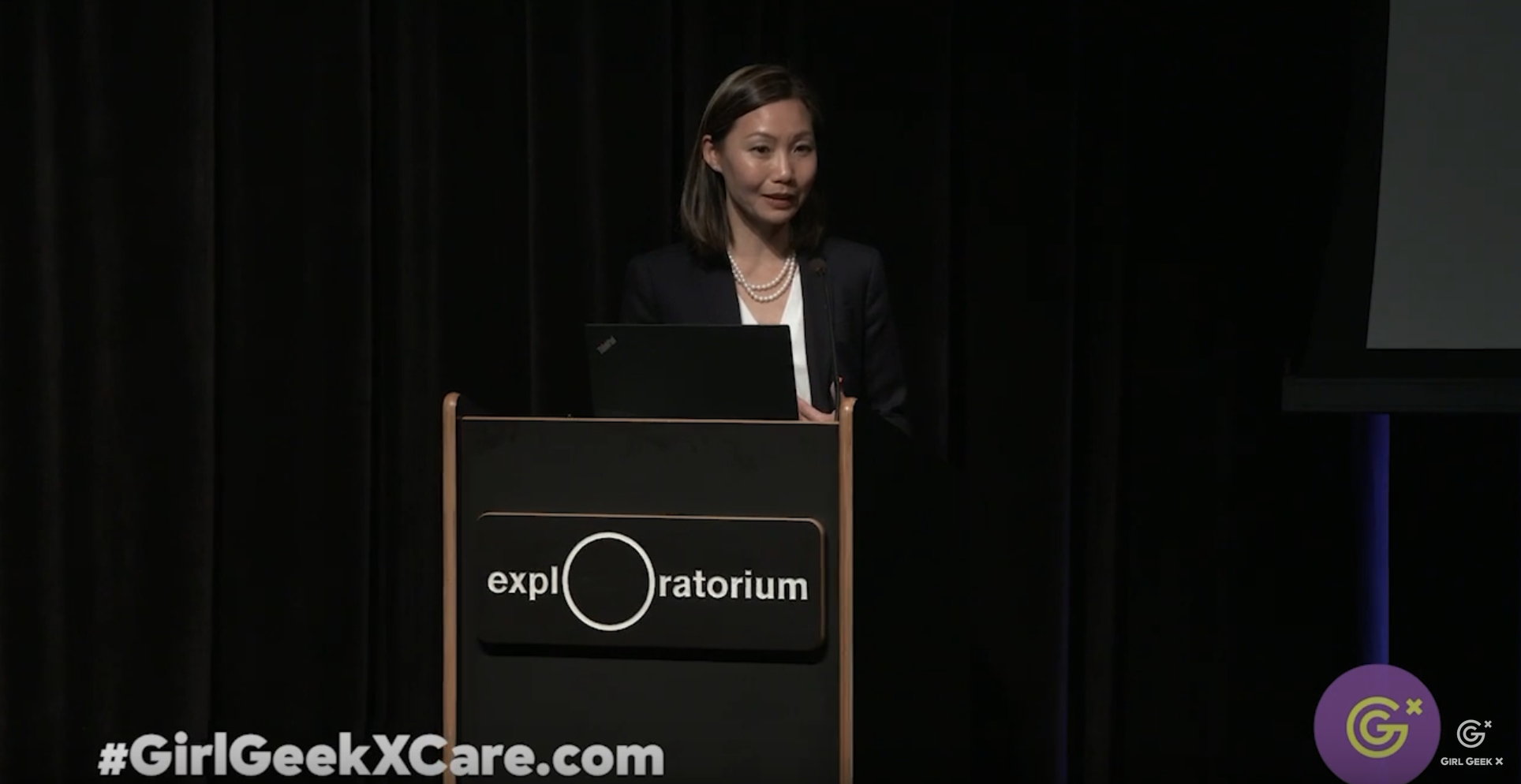
Rita Chow speaking at Care.com Girl Geek Dinner.
Rita Chow: Thank you, Connie. Hi. I’m a mom of two sons who drive me crazy. I’ve been a software engineer for about 19 years. When I was asked to speak at this event, I thought about when I’ve been in the audience at events like these and what I usually appreciate most is hearing about personal journeys, struggles and challenges. Tonight, I’ll share with you my journey, which started in China Town, San Francisco where I was born and raised.
Rita Chow: I grew up with the older generation that wanted a son to pass on the family name. You just get a sense that somehow boys were more special. Growing up, Chinese New Year’s was my favorite time of the year because we receive our envelopes filled with lucky money to bring us good fortune.
Rita Chow: I remember one time when I was eight or so, my brother got more lucky money than I did from a close family friend. I asked my dad about it and he joked that it was because he was a boy. I thought, “What? That’s not fair. Gender wage gap already?” That’s when I decided I wanted to be a feminist when I grow up, but as it turns out the family friend was my brother’s godmother, but that feeling of wanting things to be equal for boys and girls stuck with me.
Rita Chow: When I first got to college, I had no idea what I want to do or study, but I loved math. Some friends suggested I give computer science a try. I did and loved it. In my engineering class, there were not very many women. Today, UC Davis said there are almost 25% women in computer science, but when I was in school, it felt like it was less than half of that. But this wasn’t something I cared about, my focus was just completing my degree.
Rita Chow: When I started working, I was typically the only female engineer or maybe one of two. Being outnumbered didn’t bother me, but some comments started to. There was a male engineer who would say things like, “Hey, I heard you get special treatment from the boss because you’re a girl,” or “I heard that you don’t get yelled at because you’re a girl.”
Rita Chow: Seriously, when I hear this kind of comments, I try to see where they are coming from, but part of me feel defensive. If it was so easy being a girl in a male-dominated field, why aren’t there more of us, and more importantly why do we as women still feel differently? Even though I felt defensive, I was determined never to let people’s biases stop me from doing what I love.
Rita Chow: Sometimes biases have been less obvious. I remember there was a meeting, mostly men. The guy running the meeting picked my female co-worker to take notes. I didn’t really think too much about it at that time because I would have offered to take notes if needed, but my co-worker was upset. She felt he was being sexist by picking her instead of any of the guys.
Rita Chow: Today, this stood out to me when I was taking a women’s leadership class and we had a case study similar to this situation. The purpose of the study was to point out that everyone has biases and they wanted us to think about how we would handle the situation when a male colleague picks you, a woman, to take notes when there’s a room full of men.
Rita Chow: After this case study, I realized why my co-worker was upset. One suggestion given was to say, “I’ll takes notes this time, but maybe someone else can do it next time.” Fortunately, these situations didn’t happen too often for me personally, but I guess, like in college my focus was just to do my work well and enjoy what I do. More than gender bias or treatment, I’ve personally found one of the biggest challenges of being a woman in tech is balancing work and life.
Rita Chow: After I had my first son, I was very sad to return back to work after maternity leave. I just started getting the hang of taking care of a newborn and I was going to miss my son very much. When I returned, I was exhausted all the time because I was still waking up in the middle of the night taking care of my son, feeding, pumping, changing diapers.
Rita Chow: Before I knew it, he was old enough to ask me to play with him and then mommy guilt hit me. Putting down my computer was an emotional tug of war between wanting to finish my work and taking care of my son. I thought, “Should I stop working or should I find a part time job?”
Rita Chow: Well, I did neither, but I started to try to make some rules for myself. For example, I only work near my kids so that I can drop them off and pick them up or be ready to get them in case of emergency. I told myself I should not feel guilty for leaving work to pick up my son or bring them to appointments or take time off to go to their fieldtrips. When I get home I would not do work until I was there for my kids first.
Rita Chow: Another common challenge I hear from parents is finding affordable quality caregiver or daycare for moms to return back to work or during school breaks. Some decide to change to part-time, some would leave the workforce and some stay but are very stressed. In this regard, I was lucky because my mom was nearby and free to look after my sons until they were about three, but a lot of people don’t have this luxury.
Rita Chow: Even so, when they were approaching 3, I also had to start planning for preschool, school, and care during school breaks. It can be stressful because you want what’s best for them. It’s expensive and it takes a lot of time and effort because this challenge is so common and relatable, I was very drawn to Care.com’s mission to help people find that best care in the easiest way possible. Maybe if finding care for your loved ones is made easier, less women in tech would need to leave the workforce.
Rita Chow: From my experience as a female software engineer, things that kept me here were, not letting people’s biases stop me from doing what I love, keeping a work life balance, and knowing I am not alone in struggling to do what’s best for me and my family. Thank you for listening to my story.
Connie Fong: I love that final thought. Don’t let anyone stop you from doing what you love. I really want to thank you for your attention tonight. I know we’re running a little bit over, but we’d like to open the floor for some Q&A for the panelist, if you can please come back up to the stage. Who wants to go first?
Audience Member: First of all, this is so fantastic. I’ve been through a lot of these challenges. Thank you. It struck me when you’re talking, Sheila you talked about the gig economy and that you guys are a unique place where you’ve been thinking about the gig economy for years and some of these other companies. This is an open-ended question, but are there any other insights about where you think the future of work is going and was it really important to support massive workforce [inaudible].
Sheila Lirio Marcelo: I think … Is this working? I think there’s a lot that we can do. What’s interesting and we’re sensitive about when we talk about it on the branding side when we debate, we don’t really label a lot of our efforts as a gig economy effort because if you think about caregivers, we’re trying to be advocates to professionalize caregiving and sometimes gig suggests that we’re not valuing and respecting the profession that they’re entering into by calling caregiver a gig worker, but the reality is gig worker should be respected in general whether they’re part-time or full-time.
Sheila Lirio Marcelo: We are in the space even though we don’t label ourselves that way and the way we’ve been thinking about it is if we could be at the forefront of developing products and platforms overall to create more stickiness because if you think about it, Dominique talked about this, right?
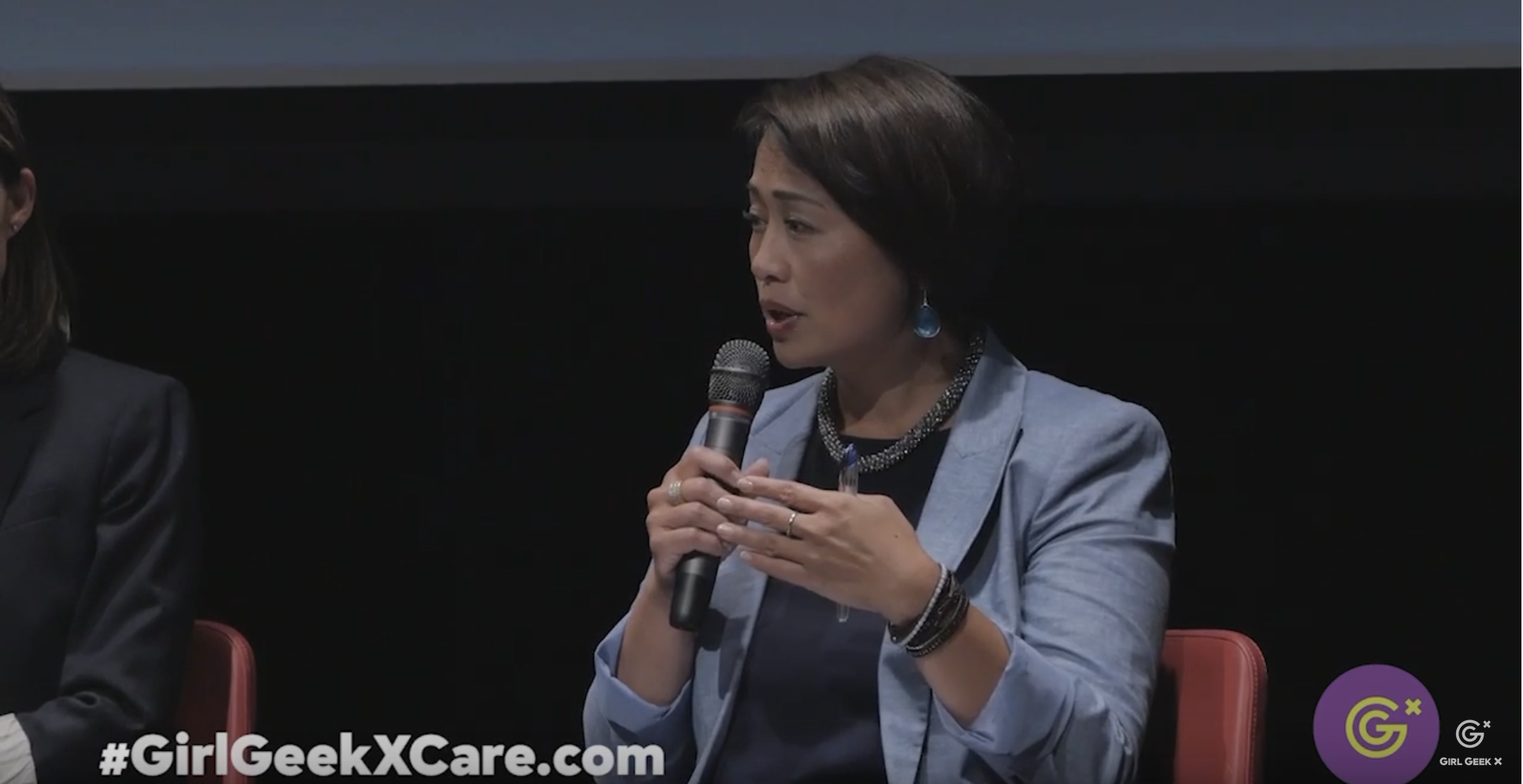
Sheila Lirio Marcelo speaking on a panel at Care.com Girl Geek Dinner.
Sheila Lirio Marcelo: It’s how do you define products but also addresses the same business strategy and if there’s ways to monetize that, but our way of monetizing it is that, as she described, if we’re attracting caregivers for free and we provide them benefits and we’re investing in it, it’s not only the right moral thing to do, but it’s actually the right business investment that we need to make.
Sheila Lirio Marcelo: The way we think about it at Care.com, whether it’s the gig economy, whether it’s the trust, or whatever it is that we’re investing in, we’re always asking ourself is it true to our values and balance that with, is it the right business decision to make, as well. That’s what makes us unique is that we can actually bring the two together.
Audience Member: Thank you.
Audience Member: To start, yes … Is it on? Oh. To start, thank you guys for sharing. All of your stories are awesome, but one of my questions, and I don’t know who can answer this, but as far as your guys’ growth being relatively new, what are some of the biggest challenges that you guys are facing and scaling when it comes to adding on new service providers and users of the platform. Like what are some of the biggest challenges that you guys are looking to overcome right now?
Sheila Lirio Marcelo: We have the head of growth, Dominique.
Dominique Baillet: Yeah. I mean there are so many things that I can think about, but I think fundamentally what it takes for our company to be successful is to always be the best place for caregivers to find a job because families come to our platform if we have the caregivers. But one of our inherent challenges is actually that we have … We are constantly trying to make sure that we actually match supply and demand.
Dominique Baillet: In different markets or in different geographies, we might have more families relative to the number of caregivers we have and then other geographies we might have more caregivers relative to the other families.
Dominique Baillet: We have to balance supply and demand and we have to do it at a regional level. Always figuring out how to manage those dynamics in the right way, I think, is one of the challenges, while still creating really a great experience for caregivers and to also create a great experience for families, because like I mentioned the families are the ones that are paying, but they’re paying because we have the caregivers. I think that’s one of the inherent challenges of a two-sided marketplace, but absolutely that’s one of the things we’re always trying to figure out.
Sheila Lirio Marcelo: Let me add to that. I think it’s hard to build marketplaces without patience. We kind of want to jump to that balance right away, so for the first five years, our focus was really more on density than it was on quality because when we polled the users in the early days other than the 8 and a half by 11 sheet that you got at your local church that you peeled off that little ear with the phone number or the YWCA or YMCA or your next door neighbor, there was really wasn’t a lot of places to go for care because the classified ads were going and maybe there’s Craigslist, if again, as Lauren pointed out, trust is really important.
Sheila Lirio Marcelo: Back then, we really prioritized choice and density and we knew the plight. When you post a job you get 200, sometimes a 1000 results if you lived in New York City. Back then that was great because when you’re looking for care anybody would with a pulse was better than not. You didn’t have a lot of access to care.
Sheila Lirio Marcelo: Nowadays, with smartphones and what Uber and Airbnb and Lyft and everybody’s really reset customer expectations that it’s about quality, it’s about the algorithms, it’s about the match that Abbey talked about, and that’s changing. And that becomes a challenge with also organizational shifts around priorities, because you’ve been focused so much on acquisition free, just get volume, volume, volume, but now you really have to invest in the product overall. It’s a shift also culturally on how we think about things.
Connie Fong: I think I’ll suggest, Dominique talks about the complexity of the two-sided market place, and then the complexity actually becomes exponentially more complex, because if you think about the caregivers who provide care, there’s a very wide spectrum of people who do that.
Connie Fong: We have a lot of college-aged care providers who are very different than your experienced care providers, so you have two very disparate sub-segments within just the supply side. And similarly on the family side, people who need childcare, their needs might be very different than people who need care for their parents.
Connie Fong: You can imagine two-sided being complex in and of itself, but when we think about from a marketing perspective, understanding the right message to the right person at the right time, the audience has become exponentially more complex within each side of the market place.
Audience Member: Thank you.
Audience Member: Thank you all for the amazing talks, by the way. The thing that really struck me was you’re all women in prominent leadership positions with kids at home and I recently took on a very demanding leadership role at my job and I’m wondering what tactics you’ve put into place to help draw the boundaries between your work and life balance that might help you maintain a better balance and a healthier life.
Sheila Lirio Marcelo: Rita?
Rita Chow: As I mentioned, I started to make rules for myself. I think it is very understandable that family is very important, and I think usually at the work, in the office people will understand that.
Rita Chow: I would make rules for myself life, like I said, when I go home, it’s hard for me to put down my computer, but I want to see my kids grow up, so I will take care of them first before I would do my work.
Lauren Chan Lee: I’ll take a stab at this one, as well. I think for me there’s three things. One is just straight up quoting Sheryl Sandberg, “Your partner has to be your partner.” For me, having a husband who is supportive is a really key thing and we really try to balance our home responsibilities.
Lauren Chan Lee: The second, like Rita said, is setting boundaries. One thing that I always make time for is, I always pick up my kids, and that’s just one thing that pretty much always stays the same except when I come to Girl Geek Dinner.
Lauren Chan Lee: The third thing for me, is you really have to like pick and choose where you want to have like your perfection and quality bar versus the things that you want to let go. One of the areas where I don’t maybe hold myself to as high of a standard as other people is just in terms of like the meals we eat. We eat a lot of repeat meals and left-overs throughout the week. I can’t cook every night, that’s just not going to happen in our house. We also have somebody come in and help out with like cleaning on a periodic basis.
Lauren Chan Lee: There are things where you just have to find help. It’s a village and so you figure out which things you’re going to value and do yourself versus you can find help on Care.com to help you do it.
Sheila Lirio Marcelo: I’m a very great, professional muffin buyer that we take to school. They’re happy that they bring muffins to school.
Connie Fong: I think women in leadership positions, we are here because we have high expectations of ourselves and I love that. I would never say lower your expectations. I remember this conversation I had with a roommate and she was like, “Connie, the sooner you realize you can’t have it all, the happier you will be.”
Connie Fong: That was like the most depressing conversation that I had with her after Sex in the City, but basically, I didn’t want that to be the path that I wanted to take, but I think the balance is, it’s fine. Have those high expectations, that’s great, but I think to balance that is also be kind to yourself and forgive yourself when things don’t happen the way that you think they’re going to happen and it’s like my house is crazy.
Connie Fong: I have three young kids under 7 and is my house perfectly clean? No, I just take out my contacts and call it a day, like I will forgive myself on that, but you know, you do what you need to do to sort of do the best that you can and have your high expectations, but really just be kind to yourself.
Audience Member: Again, thank you for doing this.
Sheila Lirio Marcelo: Thank you for being here.
Audience Member: I’m a co-founder of the leading internet care platform in Turkey, so we went through some of the same challenges you did, so it’s amazing to hear Care.com story. My question is about growth.
Audience Member: When did you, when was the tipping point for Care.com? This probably goes back a few years for you guys. How did you realize you’d get there in terms of growth? How did international expansion have an effect on your growth and for future growth, how do you see international expansion having an effect?
Sheila Lirio Marcelo: You know, our co-founder Dave Krupinski is here. I would love to turn it to you next. Yeah, I’ll let you answer it first. He’s trying to hide there in the shadows and I noticed him.
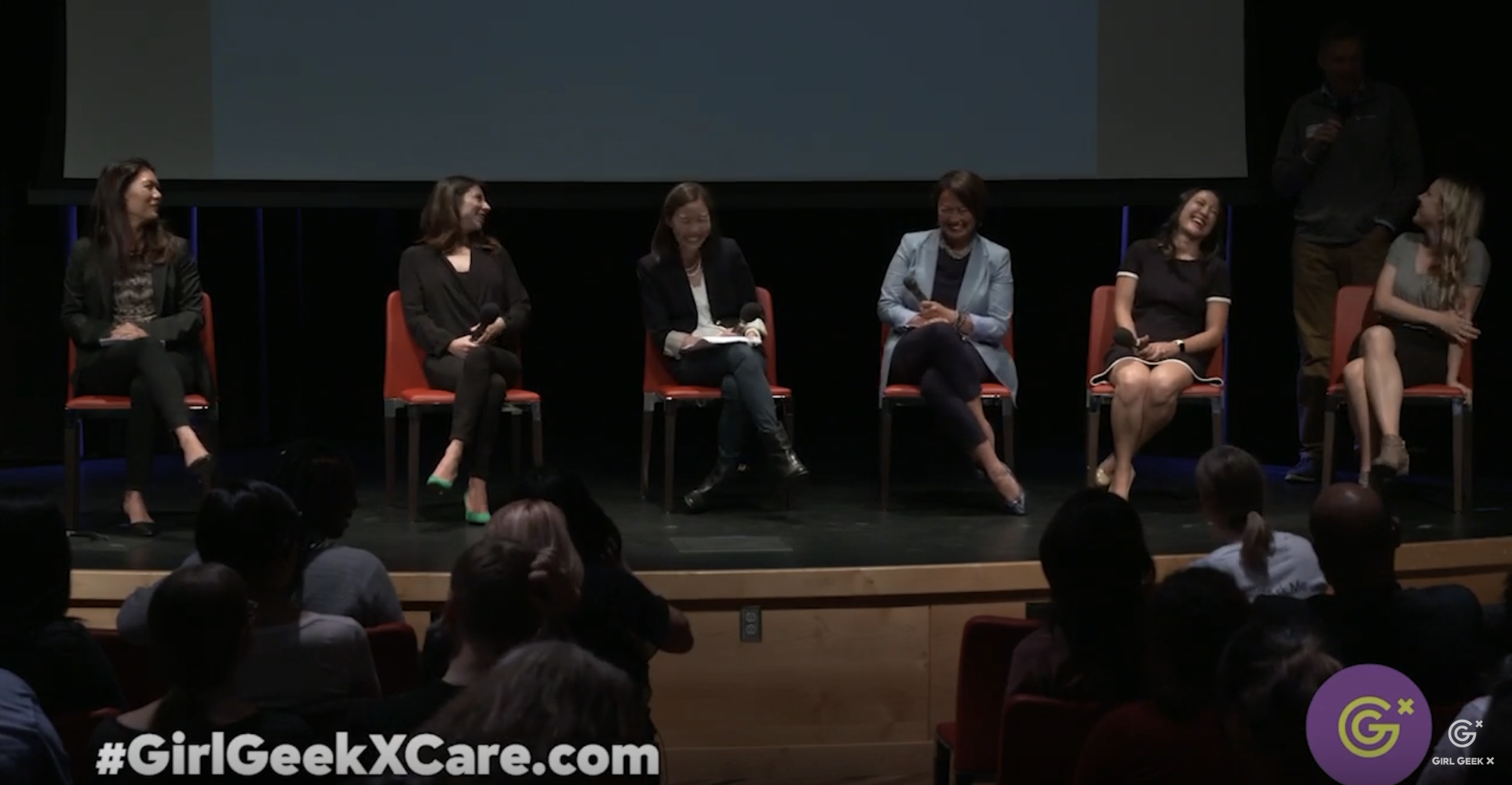
Dave Krupinski: Thanks so much for the question. I think the first part of your question was when did we experience sort of significant growth in our history?
Audience Member: Right.
Dave Krupinski: I often tell this anecdote, but I think it was at the time of the financial crisis in 2008, because while other companies were pulling back on marketing and really taking a very conservative approach to spending, we had the opportunity because we were a young startup, recently funded, to really do some experimentation with various marketing channels, especially mass marketing channels like television. We were able to produce some low cost, low budget ads but get out there buying remnant ads through Google TV’s program at the time and really begin to explore what it’s like to run a national mass market TV campaign, optimize the creative, optimize the experience when someone comes to the site, and that gave us the confidence I think and also sort of set us up for a national scale.
Audience Member: Thank you.
Sheila Lirio Marcelo: At the time, to add to that, there’s a lot of things that we do that people say that’s crazy because in 2010, being a very young startup, people thought why would you spend any money on television? That’s only for big companies and profitable companies. But we were always very experimental. We would try, test a small budget, figure it out, but we had a different thesis and that we call today the McDonald Principle. At that time, I had this thought that if in fact, I was wondering, why are all these kids going to McDonald’s and yanking their parents to go to McDonald’s when it’s unhealthy food. Something was working with virality with children, something was also working that was drawing them in to McDonald’s, right? What was it? It was that …
Dave Kopetsky: Happy Meal.
Sheila Lirio Marcelo: Happy Meal and that feeling of like, satisfaction. When we started doing TV ads, we had a rule of thumb which was everything that we do, and Connie knows it, I repeat it all the time is, is it memorable? Is it memorable? Is it memorable? Is it memorable and then the second thing is we’re going to go market and market and market, how great a service this is to kids. Because, it’s a simple message and kids get it, on a TV ad, and, in fact, anecdotally we hear it all the time. If you haven’t heard the story whereas you’ll go out to party or you’re having dinner and you’re saying, “Hey, we’re going out on a date tonight,” and the kids will pipe up and say, “Why don’t you go to Care.com?” We hear it all the time.
Sheila Lirio Marcelo: The only reason I raise examples like that is actually tipping points are all about experimentation and testing different theories and studying analogous industries and understanding the behavioral psychology, how do you grow certain businesses? We’re constantly asking ourselves that.
Sheila Lirio Marcelo: The move to quality, I said to the team recently, was when we definite it, how does Airbnb define quality now? It’s actually putting shampoos, folding the towel a certain way, tucking the bed. If we think about an Uber car, bottle of water, a little candy, the driver being super nice and saying, “Everything good?” Is the air quality good? You feel like you’re in a limo. When are you getting one of those? But, look at that definition of quality, it’s actually now defined in an offline way.
Sheila Lirio Marcelo: Constantly, we look at analogies in how we run our business and try different things and never always just assume what the rule of thumb for how we run our company should just apply. If we did that, we would have never, to Dave’s point, create an opportunity, the tipping point that built the brand from the get-go. Take risks, experiment and don’t have anyone tell you, “Well, this is the way we just do things.” I just … I would say, “Well, why?”
Audience Member: I lost my train of thought as I was raising my hand.
Audience Member: Here, pass it over. I’m sorry.
Audience Member: That’s fine. Oh, no, no. Go ahead.
Audience Member: Thank you for this. This is amazing. I look up to Sheila so much as a Filipino-American in tech so thank you for that and everyone is just amazing, senior leaders. I’m releasing a book on augmented and virtual reality, that’s the space that I work in, in March of next year. I’m currently a part of Oculus Launch Pad working on an app to release some multiplatforms. Shameless plug. I’m not trying to work here but I think you have an amazing company.
Audience Member: My question is like, thinking about outside of values of diversity inclusion, Rita, you talked about what keeps you here. For many junior women and other senior women that I’ve talked with, if they’re not founding a company within the AR and VR space, we constantly talk to each other about, “Well, what’s the culture like at the company? What are the values? Why would I work there? How would I be challenged?” These are questions I keep in mind because I decided to stop angel investing and blockchain on the side and potentially take another gig. But I’m overwhelmed.
Audience Member: I think with Silicon Valley being the buffet of options of like you can work at Apple, you can work at Google and it’s … I struggle with paradox of choice and I think looking at senior management and leadership, people like Sheila, like, “Oh yeah. I would totally work for someone who I can identify with or that looks like me.” What are the … I guess like top three values about what choices you’ve made in your career and outside of working here at Care.com that you think you could impart on us here, whether we are junior software engineers, people who are thinking about working at a company and why, just largely besides being purpose-driven, how you are challenged and why you stayed, choose to stay because I think, picking a company is very challenging when you are a senior woman engineer, like everyone you’re getting hit up all of the time. I’m wondering what made you choose here other than, say work life balance and that keeps you challenged. That’s my question.
Sheila Lirio Marcelo: Very competitive to hire each and every one of these leaders and I think this is a great question. I’m going to turn it over to Abbey first.
Abbey Stauffer: Prior to a couple of jobs ago, I worked almost my entire career in education in some way. I was never actually an educator but I worked in the tangential education space. I worked for Kaplan. I worked for an ed tech company that delivered coaching to college students and what kept me in that industry was the people were just so wonderful because everyone was grounded in a shared mission of wanting to help students and it wasn’t just a mission that they just emblazoned on the wall.
Abbey Stauffer: People really lived it and that really helped me feel energized in my work in hard times and in good times. I would say that was like looking for mission-driven work was what grounded me at the education point of my career but then as I moved out of that industry and into other industries I looked for that common thread because even if I am not working in education, I stepped into finance for a few years and now I’m here at Care, there has to be a common thread of really good people who are all truly committed to the mission that we’re working on, not just a motto on their T-shirt, but something that people really embody, that’s what’s really grounded my career.
Sheila Lirio Marcelo: Lauren, anything else?
Lauren Chan Lee: Sure. Well, I joined Care in January and before joining Care I was at StubHub for about eight years and when I was looking at what my next step was, I was looking at a lot of marketplace companies because that was a clear fit with my skill set.
Lauren Chan Lee: You actually nailed some of the key things that brought me here. One was being in Silicon Valley at a company with a woman founder and CEO is a huge draw. It’s not something you see every day.
Lauren Chan Lee: The other component for me, especially being a working mom, is that I’ve always been very passionate about how we empower women. When I was at StubHub, I was one of the founding members of our women’s group there and I was the president for a couple of years.
Lauren Chan Lee: This was a passion area of mine and I saw an opportunity to align that mission with the work that I would do every day at Care and it’s great to know that my work is actually helping both sides of the marketplace, women being empowered as working families as well as caregivers. Those were two really major components of my decision to join.
Sheila Lirio Marcelo: Connie? I thought it’s such a great question for everybody to answer.
Connie Fong: Yes, what was interesting to me when I joined this company is how altruistic everyone is. I don’t know if you’ve read my background, but all of my career before coming to Care was in omnichannel retail and I had worked for Sephora for several years and the Williams-Sonoma, Inc. company.
Connie Fong: For me, I’ll be straight up. I wanted to work for the number one business in the space that I wanted to be in. From a marketing perspective, Sephora was clearly number one in the space. From a care perspective, Care.com was clearly number one in the space.
Connie Fong: When I thought about also what was important to me, I majored in psychology and business and so for me, I wanted to be in a space where there was always irrational demand for the product. At Sephora, you’re dealing with human vanities. There’s really like uncapped potential there, and in the care space, I mean you really can’t put a price on the care for your children and how important that is. That was another, I was looking at the love space, whether it was dating, whether it was weddings, I mean, I was very strategic into thinking about what type company would make sense for me.
Connie Fong: I wanted to be number one. I wanted to have an irrational demand for the product, and for me, having three kids, like literally, the logistics and like the practicalities of finding something that would work from … I was commuting over 3 hours a day and that was just not sustainable for me. That was one logistical element that was very important. But figure out what your passion points are and figure out who the best is at it and that was my guiding principle.
Sheila Lirio Marcelo: Rita, do you want to add anything more than what you shared in your talk?
Rita Chow: It’s just mostly location. The thing I am working on is very interesting and being able to have a work life balance. I guess it’s what I’ve really said earlier.
Sheila Lirio Marcelo: That was great. Dominique?
Dominique Baillet: Yeah. I’ve actually made a lot of career moves in my life. I’ve had a number of different professional jobs, when I was earlier in my career and where I am now, I’ve always made choices based on where do I think I’m going to learn the most and where I’m going to grow the most.
Dominique Baillet: What’s interesting is that what I need to learn and grow has changed as I’ve gotten older. When I was … Earlier in my career, it was all about skill development. Where can I learn transferable skills? Where can I learn the most from mentors about like how to actually do something?
Dominique Baillet: A certain point in your career, you actually check the competency box and then you migrate over into a territory of, now you just need to be really confident and you need to be able to walk into a room, command that room and there’s a different level of skill there.
Dominique Baillet: Actually, like many people up here have said, one of the reasons I joined Care is, I’d gotten to a point in my career where I could check the competency boxes, have the degrees and all of that, but I was in environments where when I looked above, I didn’t really see examples of leaders that felt like, that’s the type of leader I can be. I found myself feeling like, wow, in order to continue to rise, I really need to change my style. I really need to do something different and it felt uncomfortable. It felt like that one is going to be hard for me to do in an authentic way.
Dominique Baillet: Coming to Care actually and being able to learn from Sheila and seeing, not only Sheila, but other executives in more senior positions than me and being like, “Yeah, I get them and I can get there with the style I have or with the skill I have and there’s other things I need to learn,” but still feeling like it was possible, and for me that was really important to continue to get that next level of confidence to truly believe that with what I have I can get there, and that frankly was just a lot harder if I was in environments where I couldn’t look above and see examples of leaders like me.
Sheila Lirio Marcelo: I’ll just add to this, it’s so competitive in the Bay Area in lots of different areas but even more so here, you get recruiters are pinging you the time. There’s just so many opportunities, they’re pitching the next startup and I think … or company, some great companies.
Sheila Lirio Marcelo: I think the thing that I’ve been focused on in my career is long-term relationships.
Sheila Lirio Marcelo: I probably interviewed once and updated my resume from one of my first jobs and I haven’t since because I just kept moving from company to company, following leaders that I believed in that actually gave me opportunities and continue to help grow me and believe in me, because that’s difficult to replicate.
Sheila Lirio Marcelo: There will be plenty of startups, there will be plenty of sexy new technology, there will be plenty of great, great opportunities, recruiters will always pitch you. If you follow the opportunity in the pitch, sometimes you luck out. It’s going to be great and then you could retire young, which there’s a lot of potential of that in the Bay Area, but then there’s also what the journey of life, which is who do you want to be around.
Sheila Lirio Marcelo: There’s definitely purpose, but I think, there’s also just the richness of where we spend most of our time, majority of our time in our lives, and so, if in fact, you enjoy the people that you work with and you found that tribe, I’m always encouraging people to say try and stick with that tribe, move from company to company and there’ve been times when I’m completely fine when somebody says, “Look, we’ve worked together. I’m going to leave for a little bit” and we’ve had people boomerang back or we work two or three companies later together. It might not be the next one.
Sheila Lirio Marcelo: It’s just something to think about as you look at opportunities, is to actually look at the people in your life. Who is helping continue to sponsor and help you grow and catapult you to opportunities because they know you well and that’s really want to do in your career, would be my just a small piece of advice.
Connie Fong: Thank you so much for all of your questions. I know we’re running a little bit over time but we’re actually going to stay for a little bit so you can definitely come find us to ask questions. We really want to thank you for your attention, your engagement, your questions this evening. It was a great opportunity for Care.com to be here tonight and thank you again so much for taking the time.
Sheila Lirio Marcelo: Can I just say, thank you for the entire Exploratorium staff. Thank you so much. Thank you to Erin and the entire crew in white shirts who just made this beautiful. I mean we get to up here represent, but thank you so much. You guys made this happen. Thank you.
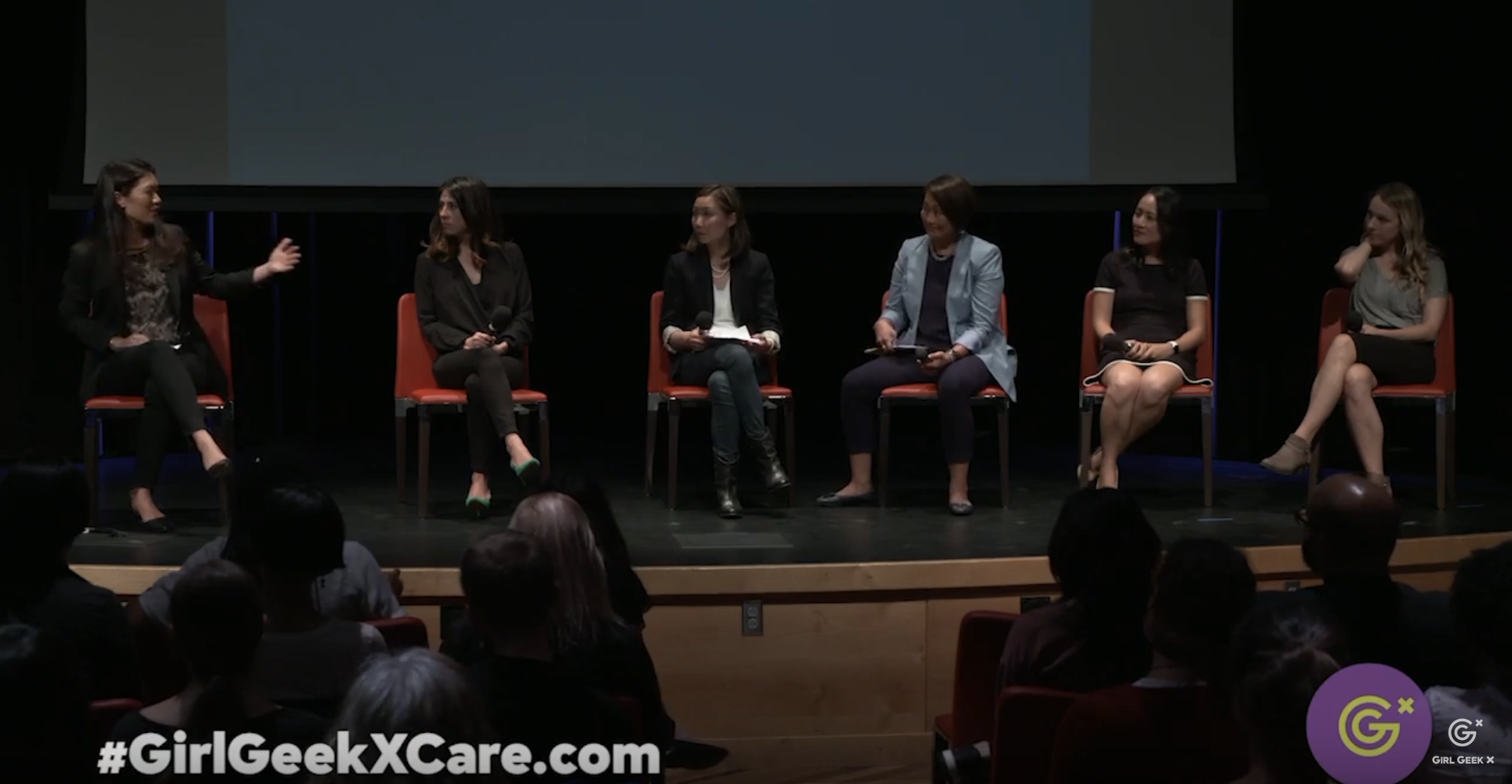
Like what you see here? Our mission-aligned Girl Geek X partners are hiring!
- See open jobs at Care and check out open jobs at our trusted partner companies.
- Does your company want to sponsor a Girl Geek Dinner in 2021? Talk to us!



